
Istanbul to Dubai
October 31 - November 21, 2022
Mike and Judy Henderson
In this installment we sail through the Suez Canal, around the Sinai Peninsula, and up to Aqaba. Then we visit Petra and Wadi Rum

+++++++++++++++++++++++++++++++++++++++++++++
11/9/2022 (Wednesday, Ashdod) We woke up to a hard rain this morning.
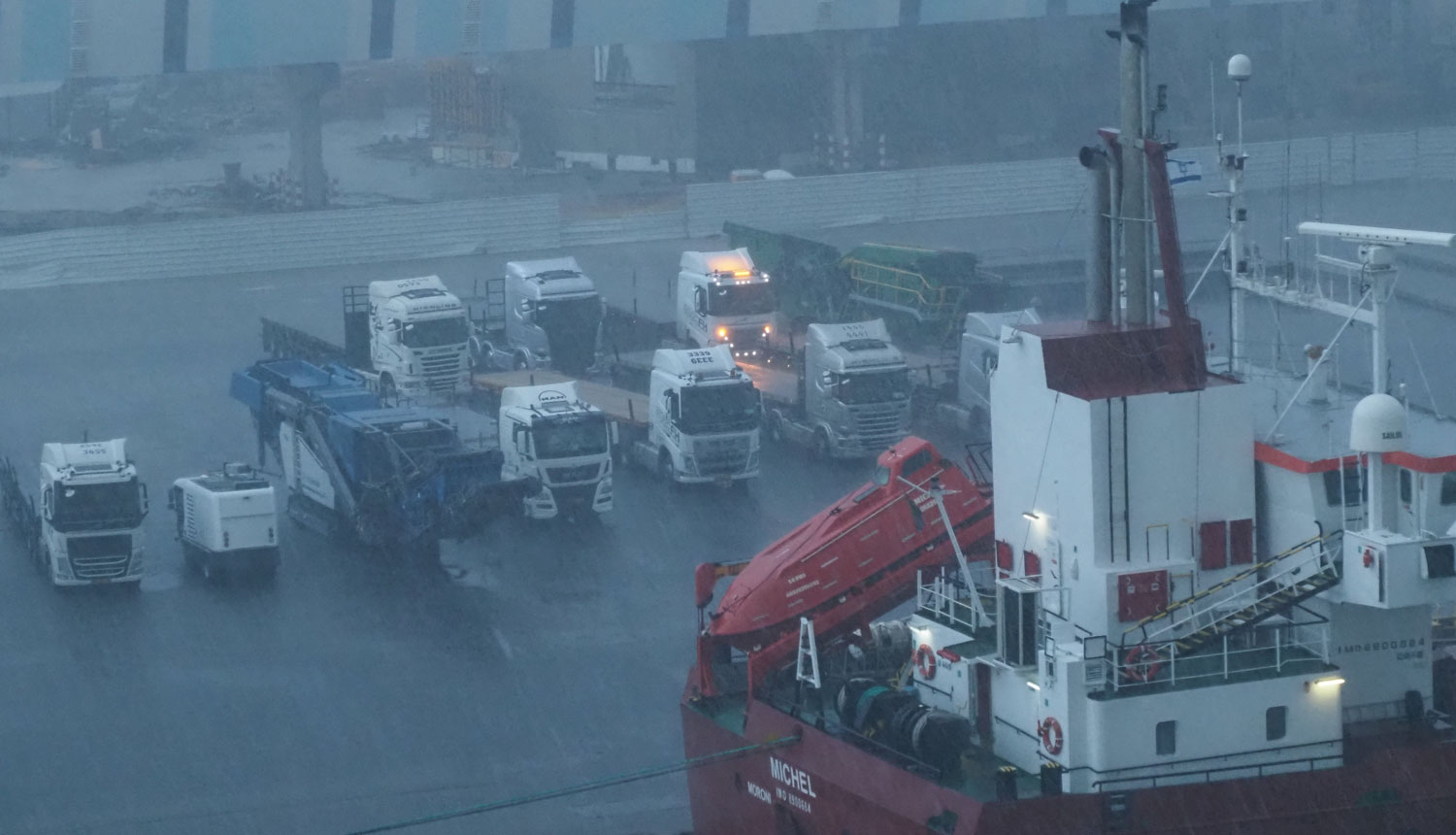
Here's a bulk carrier that was docked near us. It was carrying pipe, and we watched yesterday as they slowly unloaded the pipe. Notice the rain water running off the ship.
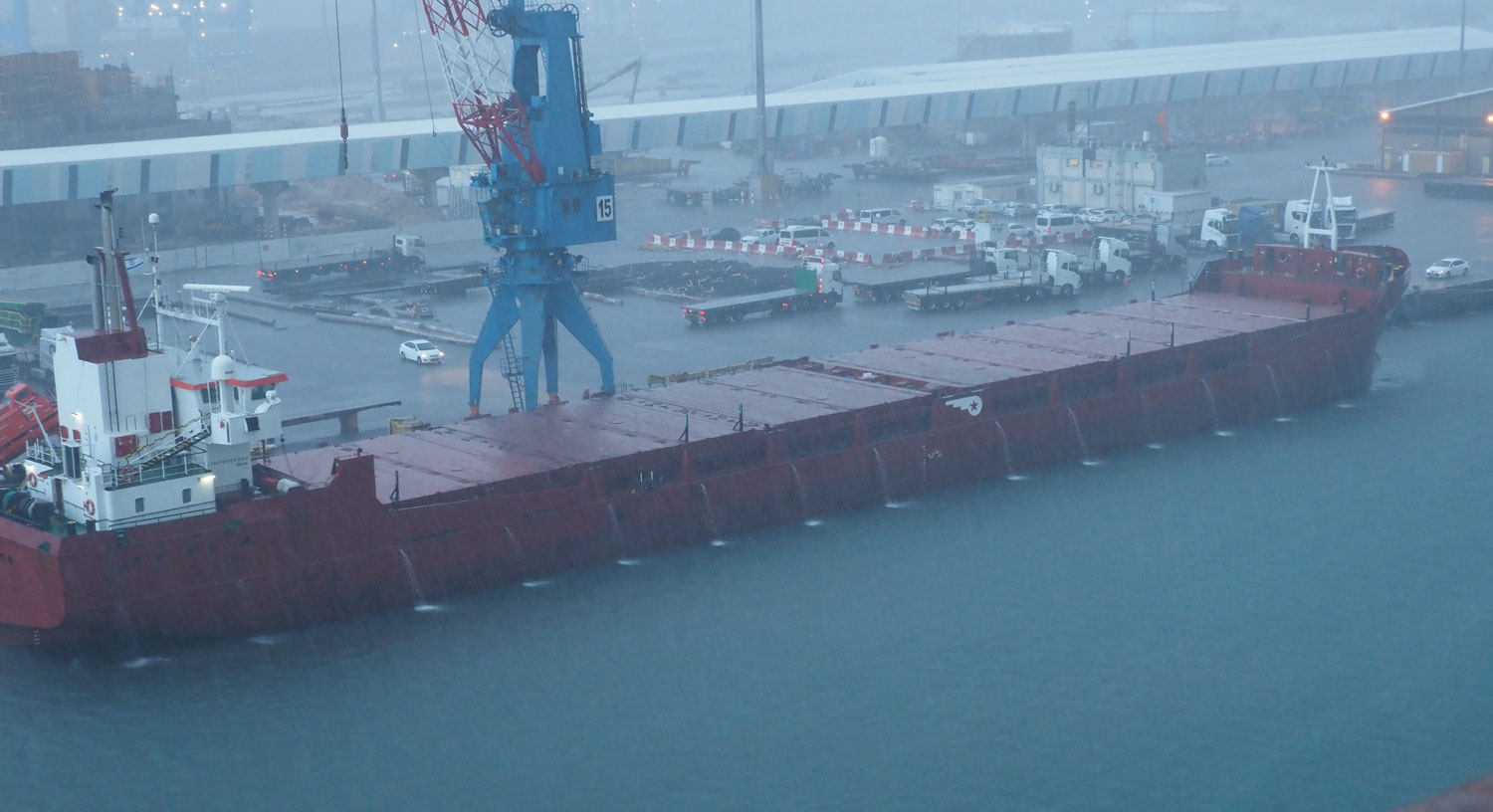
Our ship is only in port for the morning, and we had scheduled a visit to some caves outside Jerusalem (not the Wailing Wall caves). Yesterday they changed the effort level to "strenuous", and Judy decided not to go. I was still suffering some effects of the cold that started in Haifa, and with the rain, I decided not to go, either.
Unfortunately, Judy seems to have caught my cold. Hopefully, she can recover quickly.
We took it easy in the morning, until the ship departed about 2pm toward Port Said to enter the Suez Canal.
The Suez Canal was opened in 1869. Ferdinand de Lesseps organized a company and received the rights from Egypt to dig the canal. He later attempted the dig the Panama Canal, starting in 1881, but failed for a variety of reasons, one being that he tried to dig it as a sea level canal instead of a canal with locks. After his failure in Panama the US government took over the project in 1904. Judy and I did a transit of the Panama Canal back in 2016. You can see that transit here.
The Suez Canal is a sea level canal. It is not wide enough to allow two way traffic, so ships are "convoyed". The southbound convoy starts at 3:30am at Port Said and the northbound convoy starts at 4:00am at Suez. The two conveys pass each other in a dual channel area of the canal, about mid-way, in the Great Bitter Lake, and just north of the Great Bitter Lake. Doing it that way allows them to operate the canal like a funicular.
Here's a map of the canal.
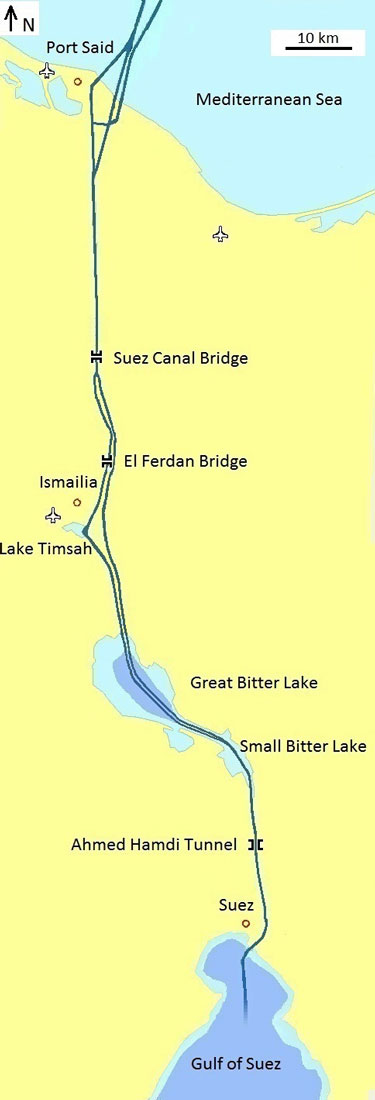
The captain announced that we would enter the Suez Canal about 3:30 in the morning.
That evening I set my alarm for 3am so that I could see our entry into the canal. But when I woke up, we were just sitting still, off the coast, along with a number of other ships.
I reset my alarm for 3:30 but when I got up then, there was still nothing going on. About 4:30 we did enter the canal, but maybe we were in the back of the convoy. It was dark, so I didn't get a lot of pictures. Here's one taken with my iPhone, which takes good pictures in very low light.
It was nearly a full moon. The iPhone makes it look like there was more light than there really was. The sky was really dark.
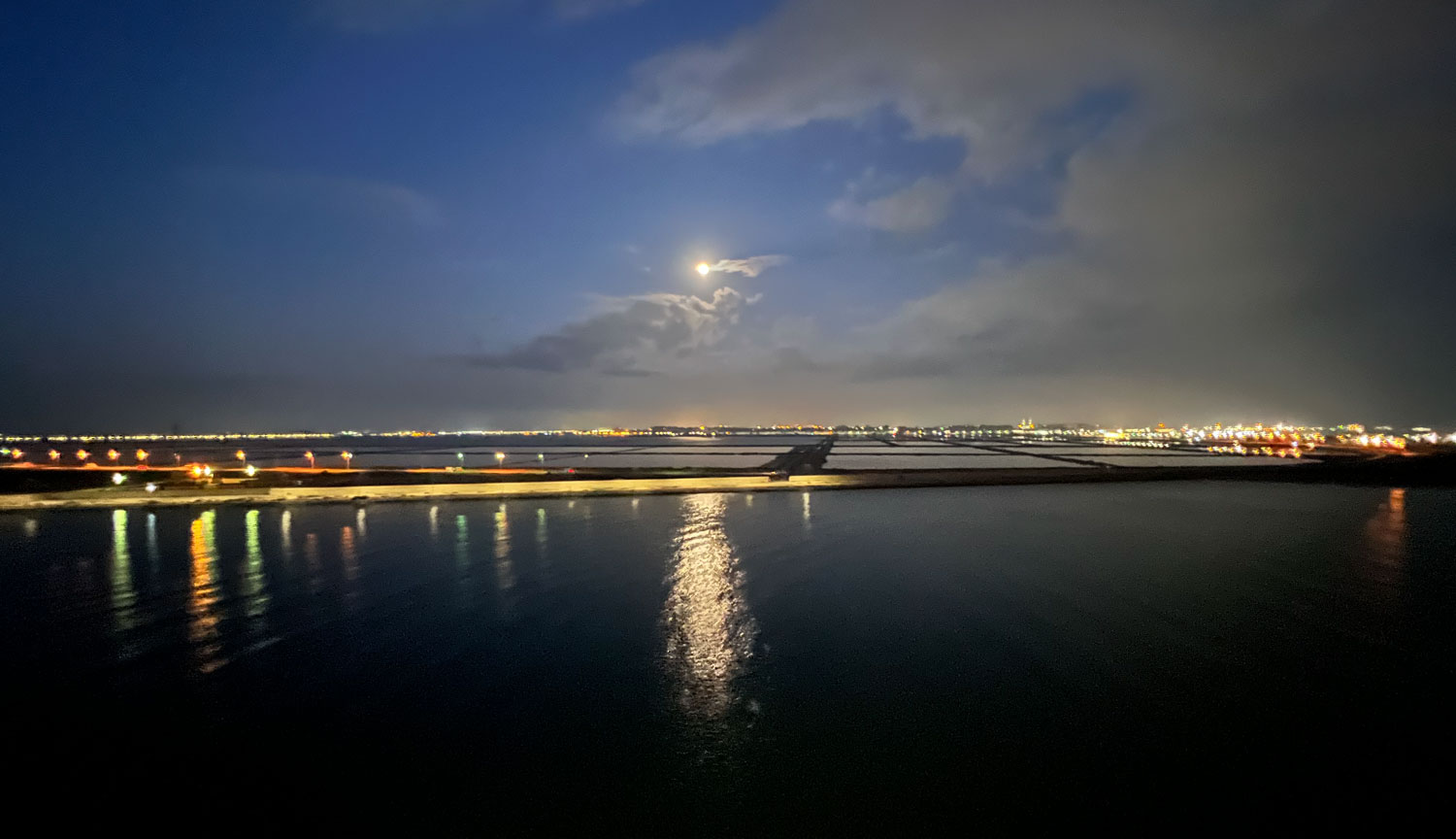
Like the Bosphorus, the Suez Canal (and the Red Sea) is the demarcation between two continents, here between Africa and Asia. The Bosphorus was between Europe and Asia.
As we sailed south in the canal, I took pictures of the scenery. As we came into El-Qantara, this photo shows a couple of interesting things. The first is the fence along both sides of the canal, essentially all along the waterway. The second thing is in the far left hand side of the picture - the Suez Canal Bridge. Built with the Japanese, it's a four-lane auto bridge.
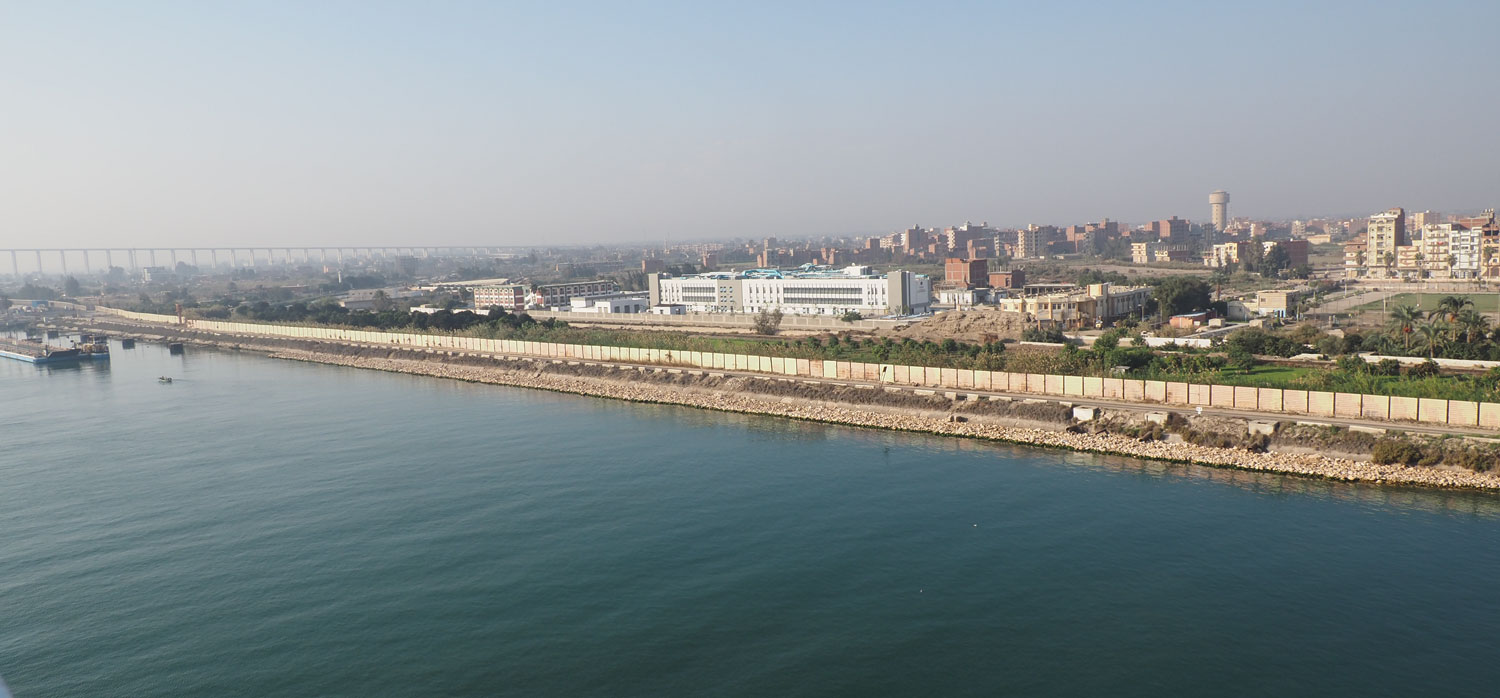
I ran to the front of the ship to take a picture, but had to take it through the glass of the Observation Lounge, and my picture wasn't very good. Here's a better picture from the web (Wikipedia).

Egypt has done some work on expanding the Suez Canal, primarily by extending the second canal alongside the existing canal near the Great Bitter Lake. One problem is at the El-Ferdan railway bridge - it only crosses the old canal. They are building an equivalent across the new canal.
I took this picture in the Great Bitter Lake. We were headed south and some of these ships were headed north. Some appeared to be anchored.
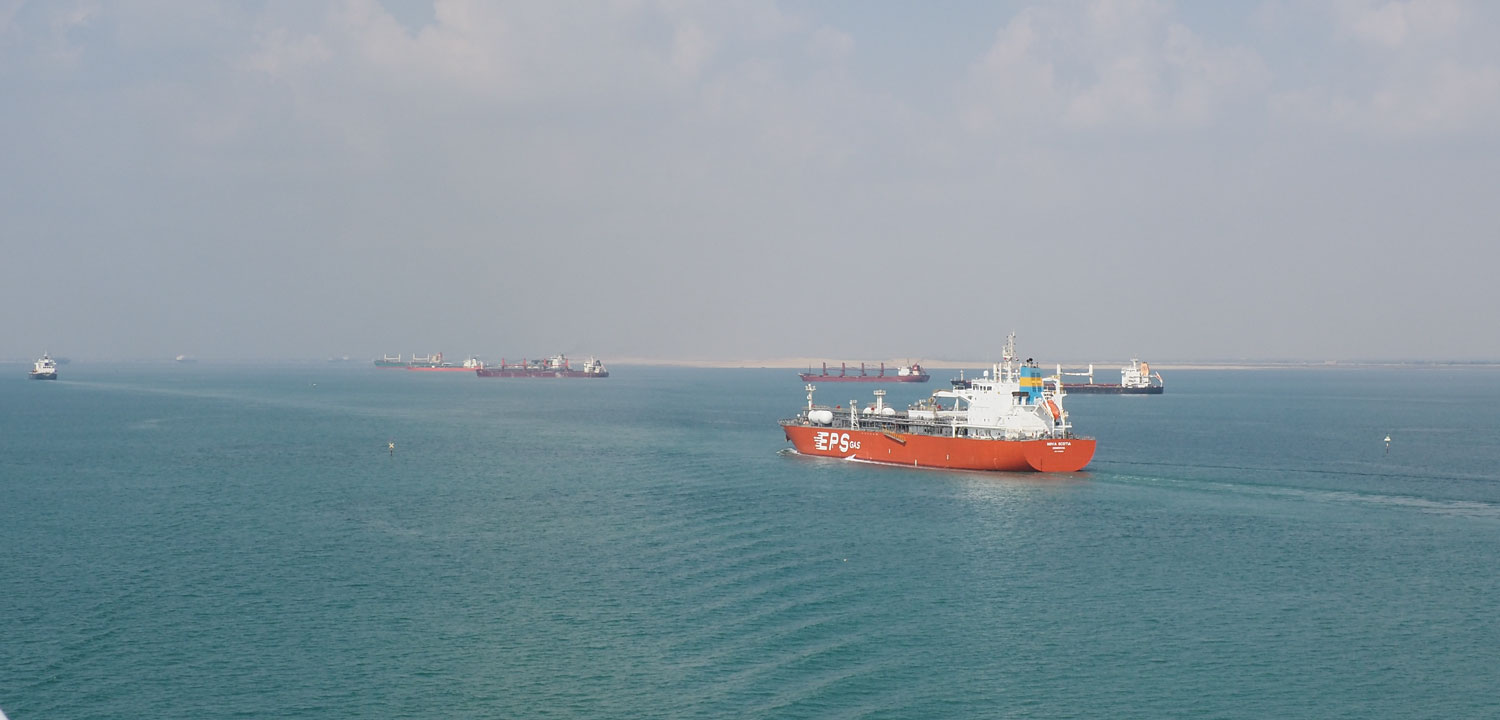
There's actually not that much to see as you transit the Suez Canal. There's a lot of desert on both sides.
As we were coming into Suez, at the end of the canal, the canal curves and I took a picture looking back, to show the other ships in the convoy.

The outskirts of the city of Suez.
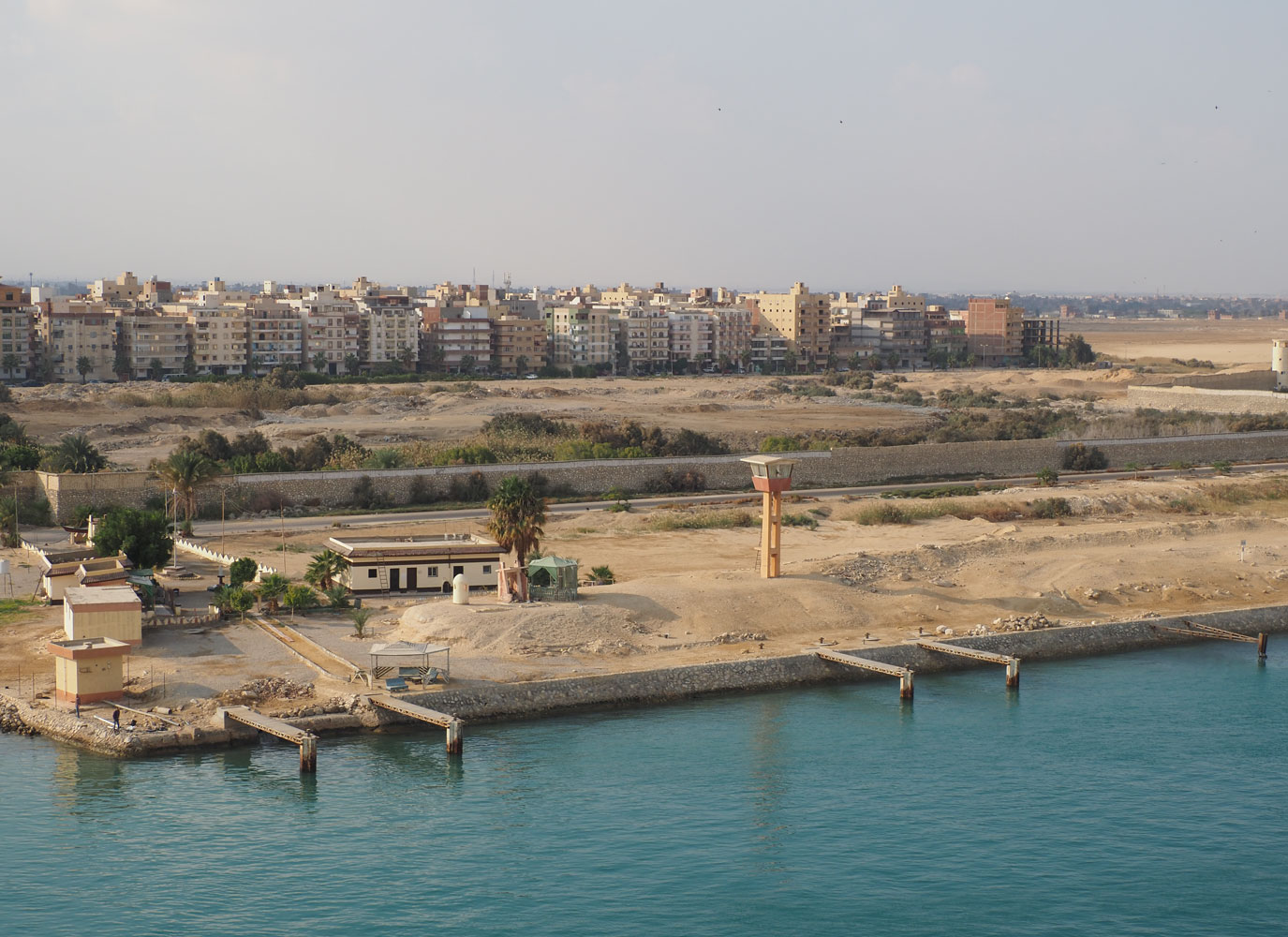
A view of the southern part of the city.
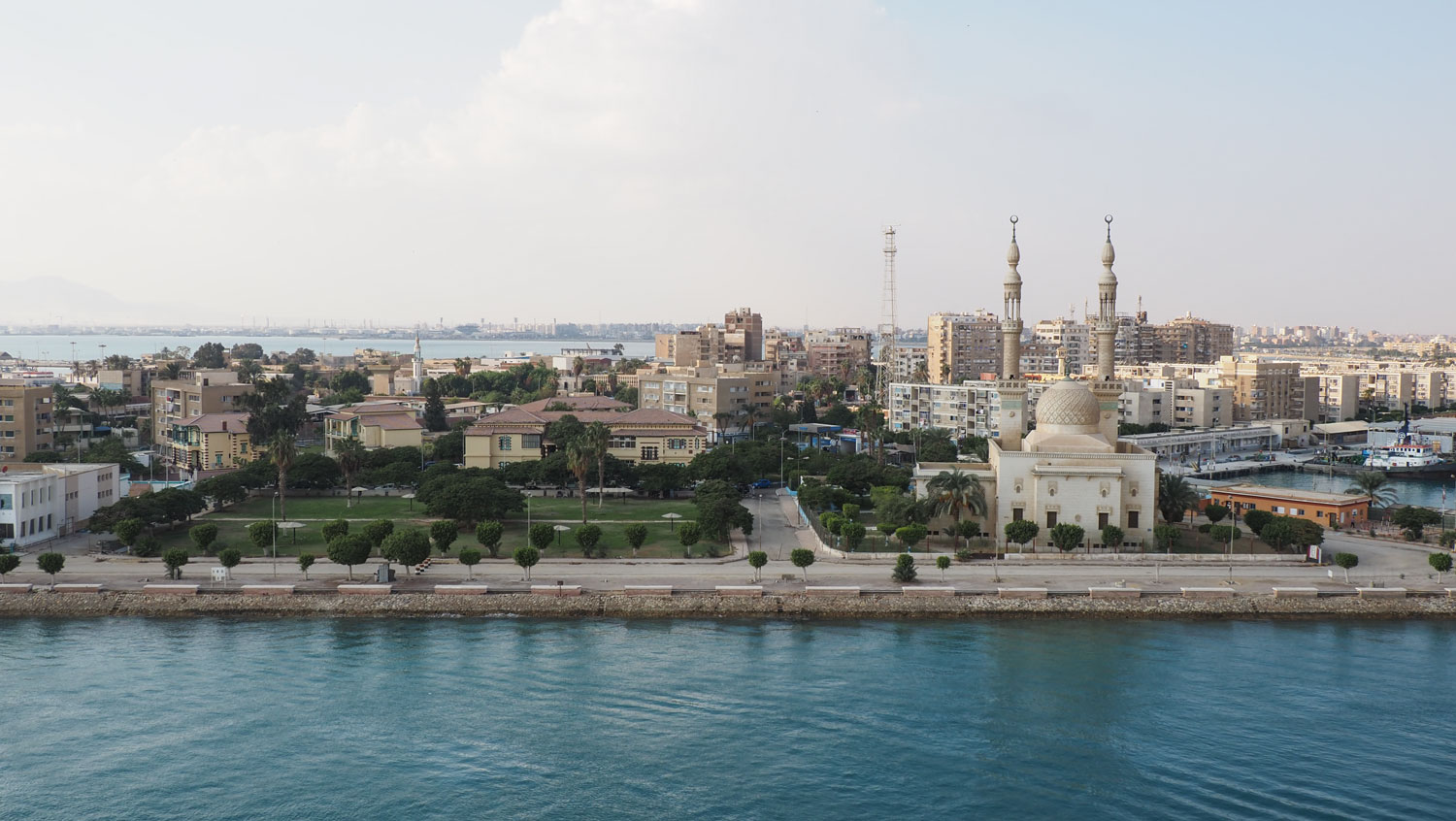
And there's the end of the canal - as we enter the Gulf of Suez.

But we have a long way to sail - going down the Gulf of Suez, around Sharm El-Sheik, through the Straits of Tiran, and up the Gulf of Aqaba to Aqaba. In 1967 Egypt closed the Straits of Tiran to ships headed for Israel. While not the main cause, it contributed to the 1967 (Six Day) War.
In that war, Israel occupied the Sinai Peninsula and held it until 1979, when Egypt recognized Israel and a peace treaty was signed between the two countries. Anwar Sadat, who signed for Egypt, was later assassinated, mainly because he recognized Israel.
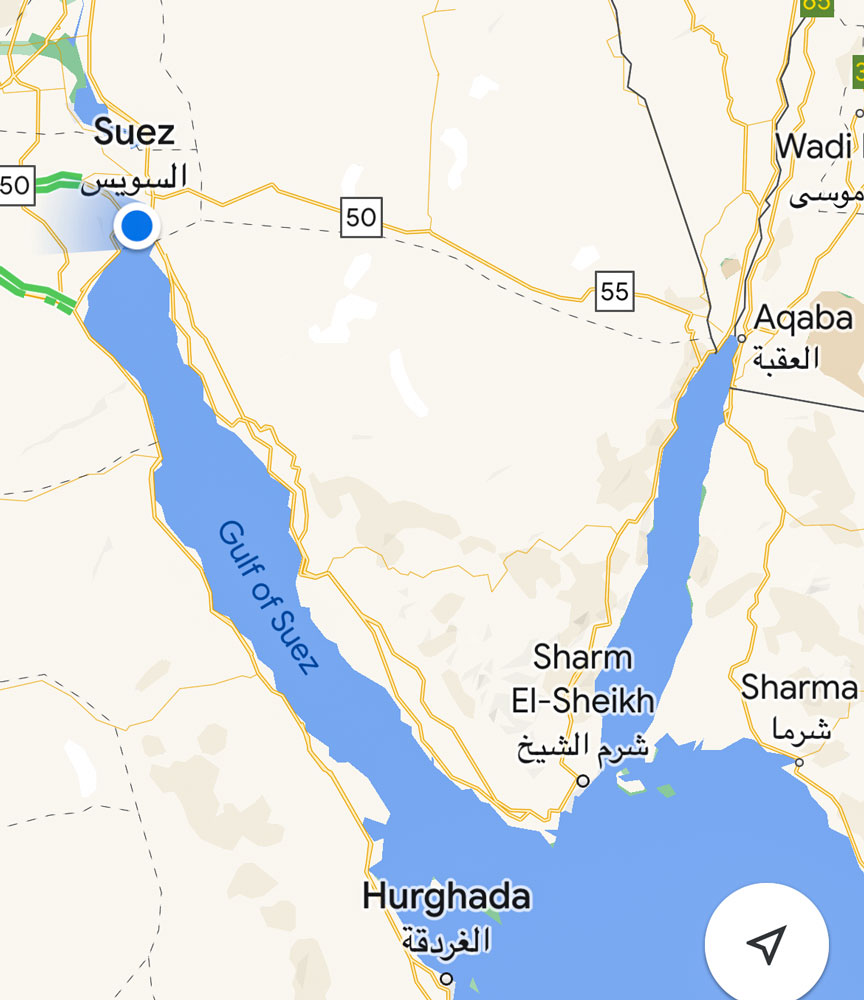
By the time we went to bed, we were still sailing.
+++++++++++++++++++++++++++++++++++++++++++++
11/10/2022 (Thursday) When we woke up this morning, the ship was still in the Gulf of Aqaba. We were a bit late arriving in Aqaba and all the early morning tour departures were delayed.
I know Aqaba from the movie "Lawrence of Arabia". Lawrence talked Sherif Ali ibn el Kharish (Omar Sherif) into the project and together they went to the leader of the Howeitat, Auda Abu Tayi, and talked him into joining the attack (in real life it was Sherif Nasir and not Sherif Ali). The scene where they convince Auda to join them is famous, both for dialog and acting. You can see it here on YouTube.
Anthony Quinn played Aud Abu Tayi, and was so good in the role that he was mistaken for an Arab by others during filming.
The attack on Aqaba was not at all like it was depicted in the film.
Outstanding movie and highly recommended. See it on as large a screen as you can.
+++++++++++++++++++++++++++++++++++++++++++++
Judy was not feeling up to a 12 hour excursion, so I went alone. We go to Petra and then to Wadi Rum.
As I was waiting to depart the ship, I saw a mirror and took this self-portrait. I flipped the image horizontally in PhotoShop so it wouldn't be reversed.

It's a two and a half hour drive to Petra. The land is very dry. Jordan has a very serious water problem - it's one of the driest countries in the world.
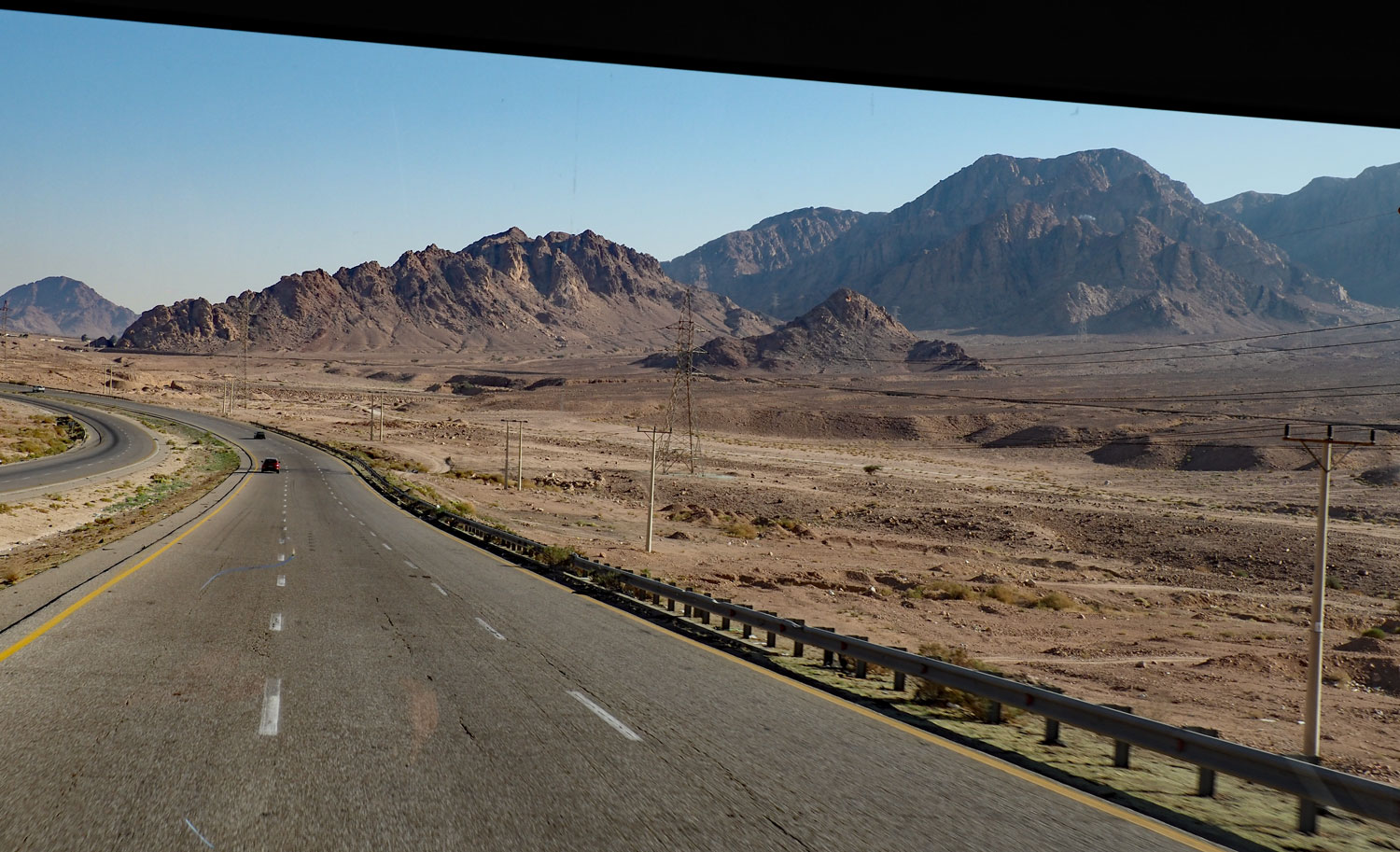
Jordan built a desalination plant in Aqaba that opened in 2017, and is now planning a larger desalination plant in Aqaba that will not be completed for at least five years. They plan to pump the purified water to Amman, and the effluent brine to the Dead Sea. They are installing wind turbines and solar farms to generate electricity to power the desalination plant.
Israel has proposed that, after the plant is completed, Jordan will provide water to Eilat, and Israel will provide water to northern Jordan from the Sea of Galilee. But nothing is simple where water is concerned in the middle east. The water from the desalination plant will be expensive while the water from the Sea of Galilee is essentially free. Negotiating a "fair" agreement will not be easy.
After about an hour of travel, we stopped at a souvenir shop to use the restrooms.

From here we could see the land where Petra is located. In ancient times it was an active hub of trading routes in the region.
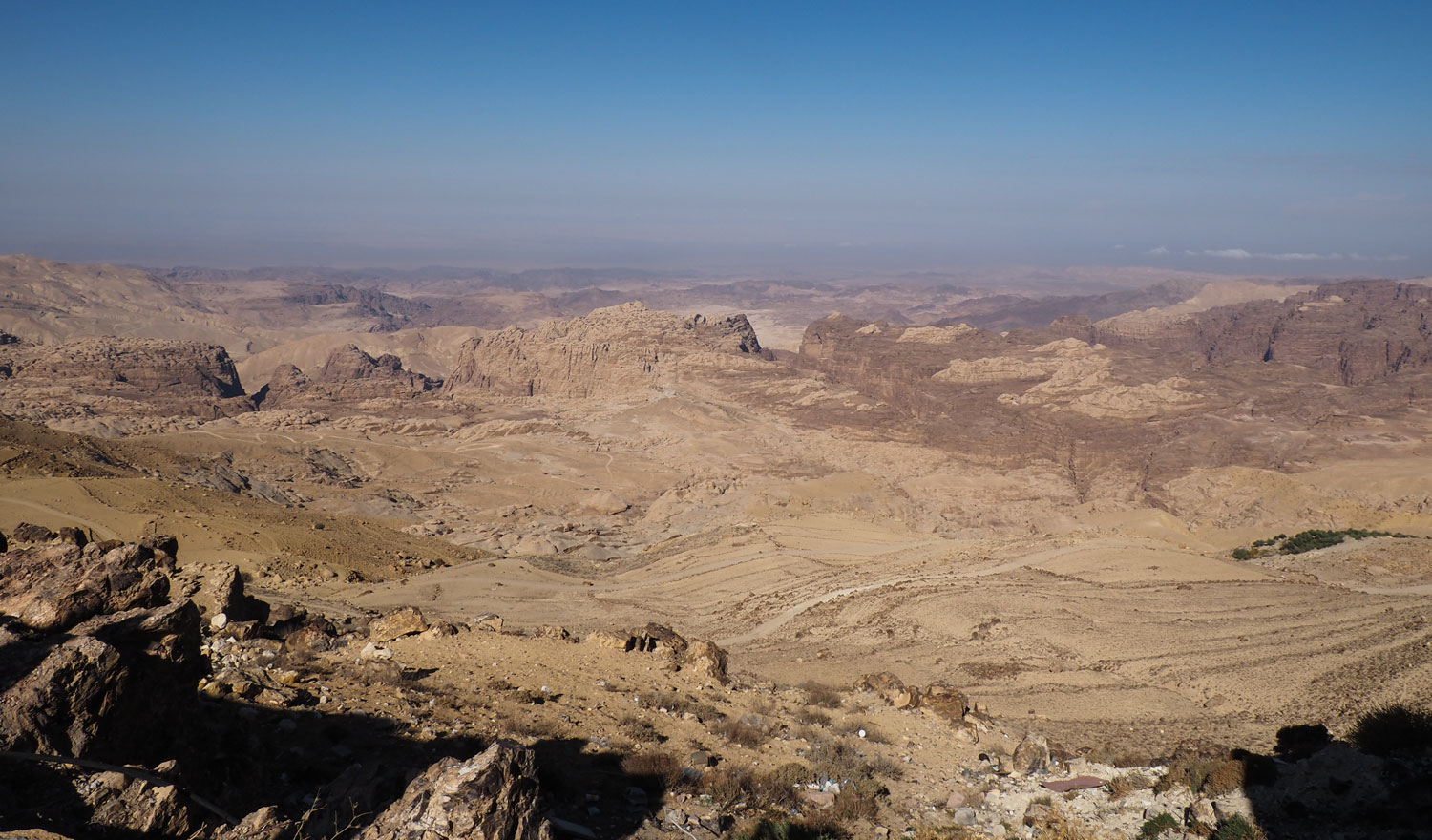
When we got to Petra there were a lot of buses there before us. Petra is going to be crowded. There was one bus there with a Tauck sign on it. We came to Petra in 2017 with Tauck. We stayed in the Movenpick Hotel at Petra, which is a easy walk away from the entrance. A land tour, as we did with Tauck, is very different from what I'm doing today. We basically had all day at Petra (if we wanted to spend that much time) with a guide. And then we had dinner at Little Petra in the evening.
Today, we only have about 2.5 hours at Petra because we're also doing a visit to Wadi Rum in the afternoon, and it takes hours to travel to, between, and from the sites.
You can see our 2017 visit here.
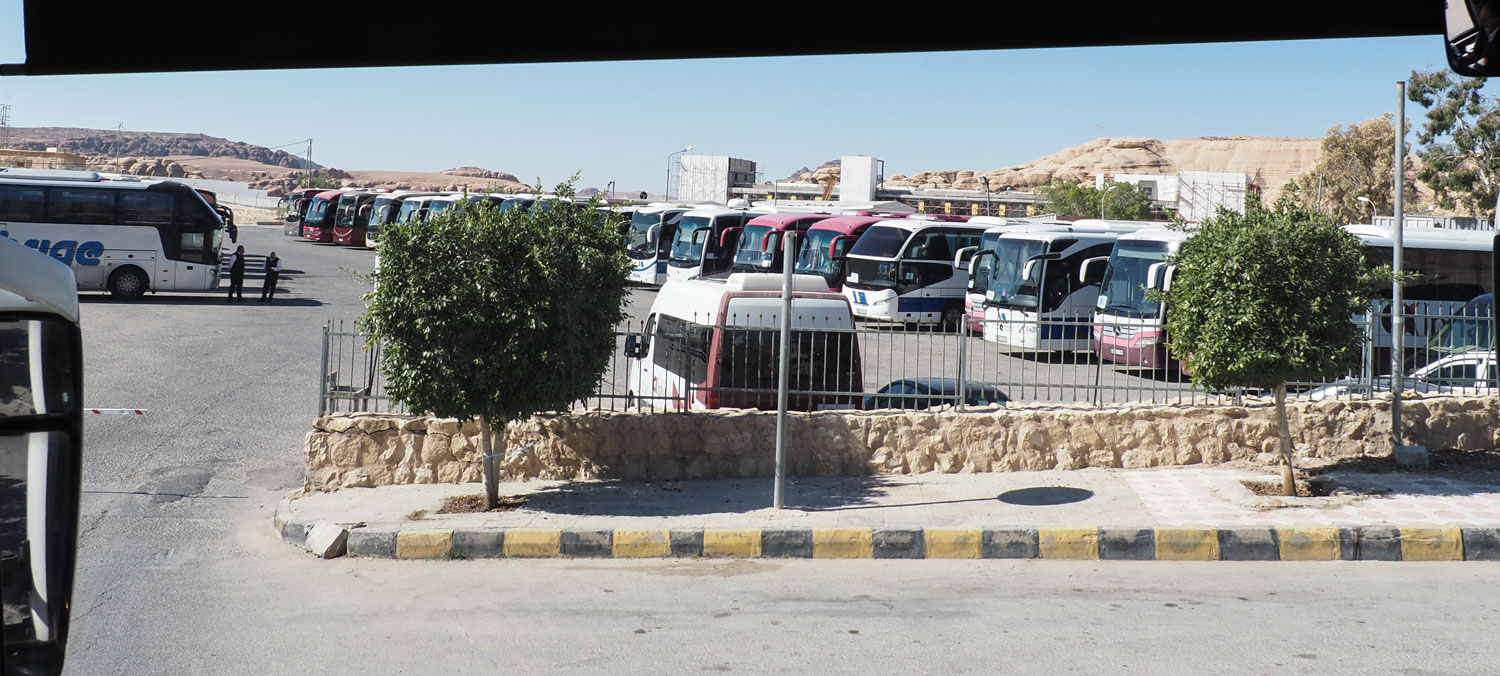
The tour director wasted no time getting us into Petra.
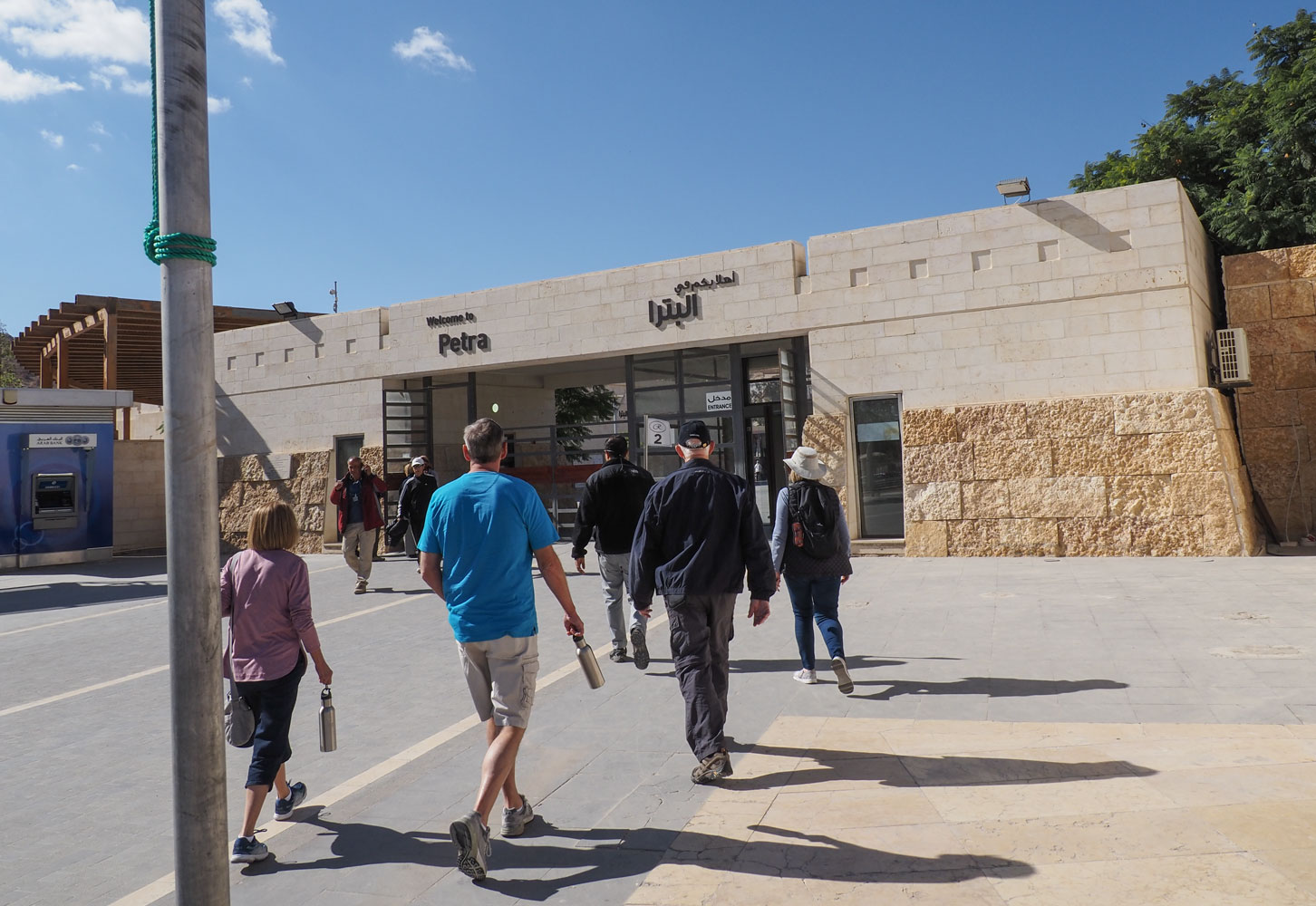
The same souvenir shops were there as in 2017.
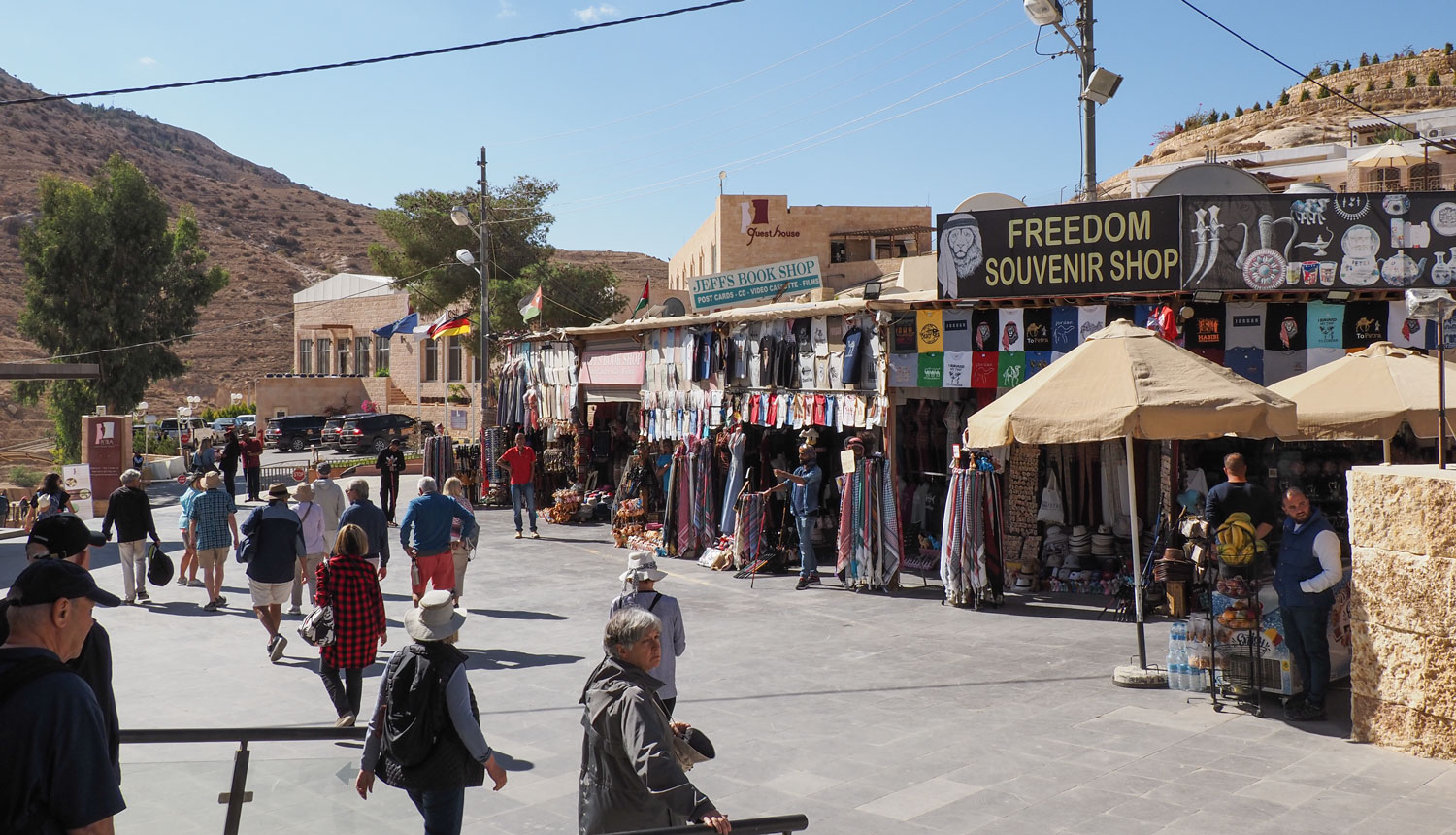
Here's a map of Petra. There's a lot to see if you really want to cover it. The word Wadi means a valley, or a dry riverbed that becomes a waterway during a heavy rain. You can see the visitor center at the bottom right. We walked along the Al Siq and came to the Al-Khazneh (Treasury). I visited the Urn building.

We were soon on the trail to Petra.
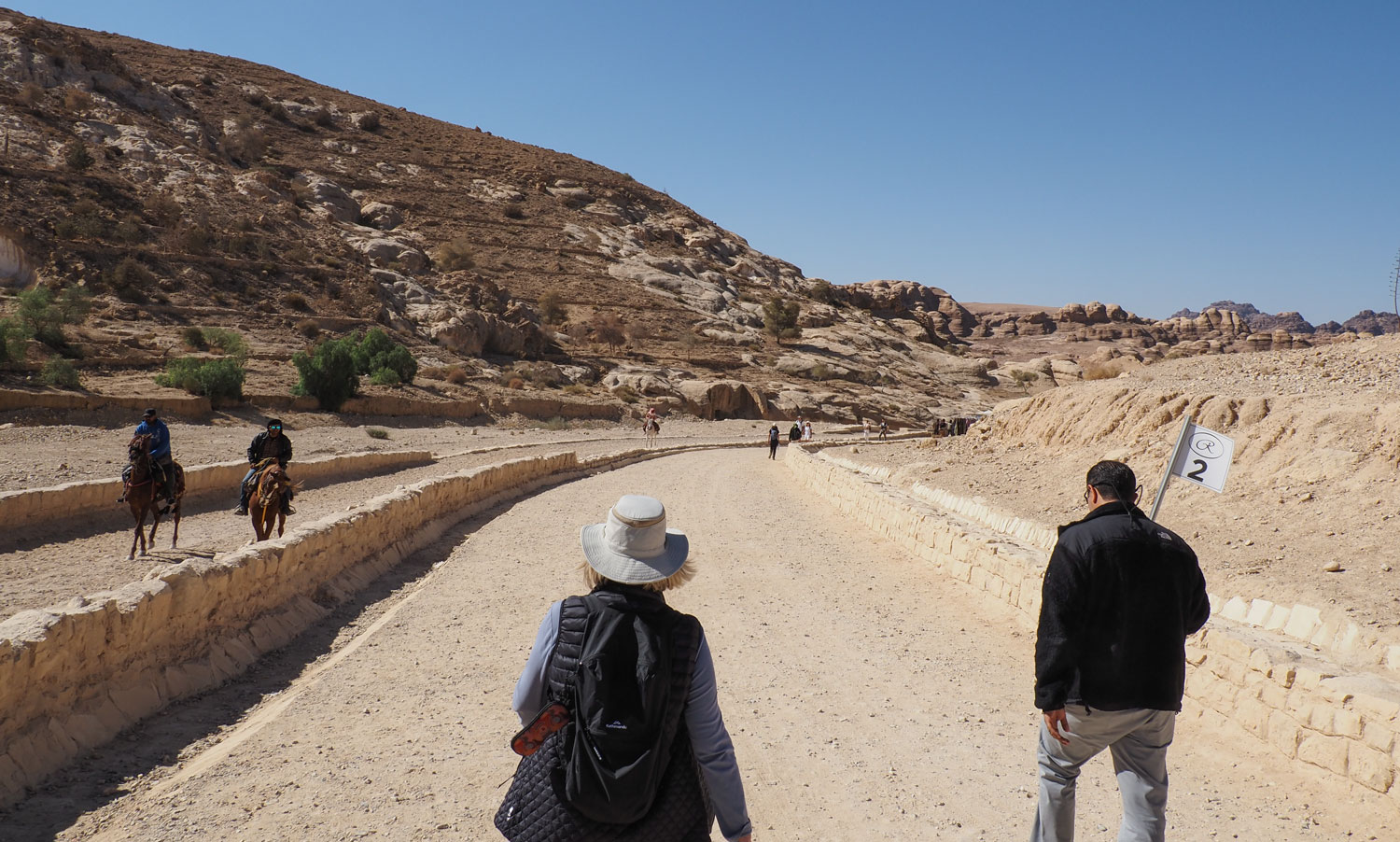
They've made some changes at Petra since the last time we were there. One thing is that they run golf cart-type vehicles along the trail to and from Petra. However, it's not cheap. To ride both ways is about $36 and you can only purchase a ticket before you start - you can't purchase a ticket after you're in Petra. That's important because the trail runs downward to Petra so coming back is more difficult than going. If you decide you need a ride back, the only option is the horse drawn carts.
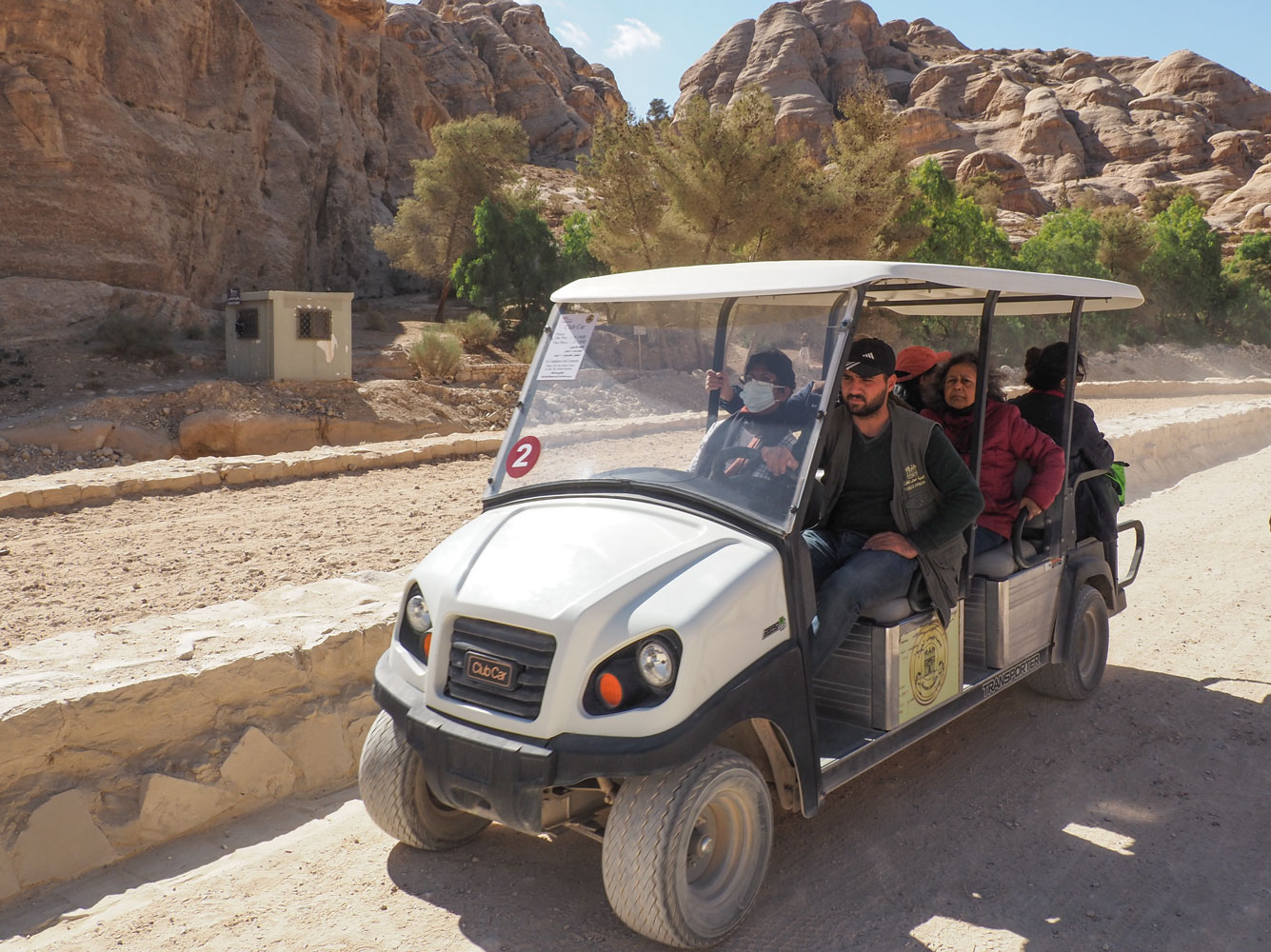
Here's a picture of one of the horse drawn carts from inside the Siq. The horse drawn carts are owned by individuals, not very well regulated by the government. You negotiate a price before you get in. But then, they stop about half-way and demand more money. That's what's happening in this picture.
As I walked past the cart, I could hear the woman on the far side of the cart saying something like, "No, we paid for a ride all the way." I didn't stick around to see how it came out, but the drivers are experts in getting more money from the tourists, so I expect the tourists paid a bit more to continue the ride.
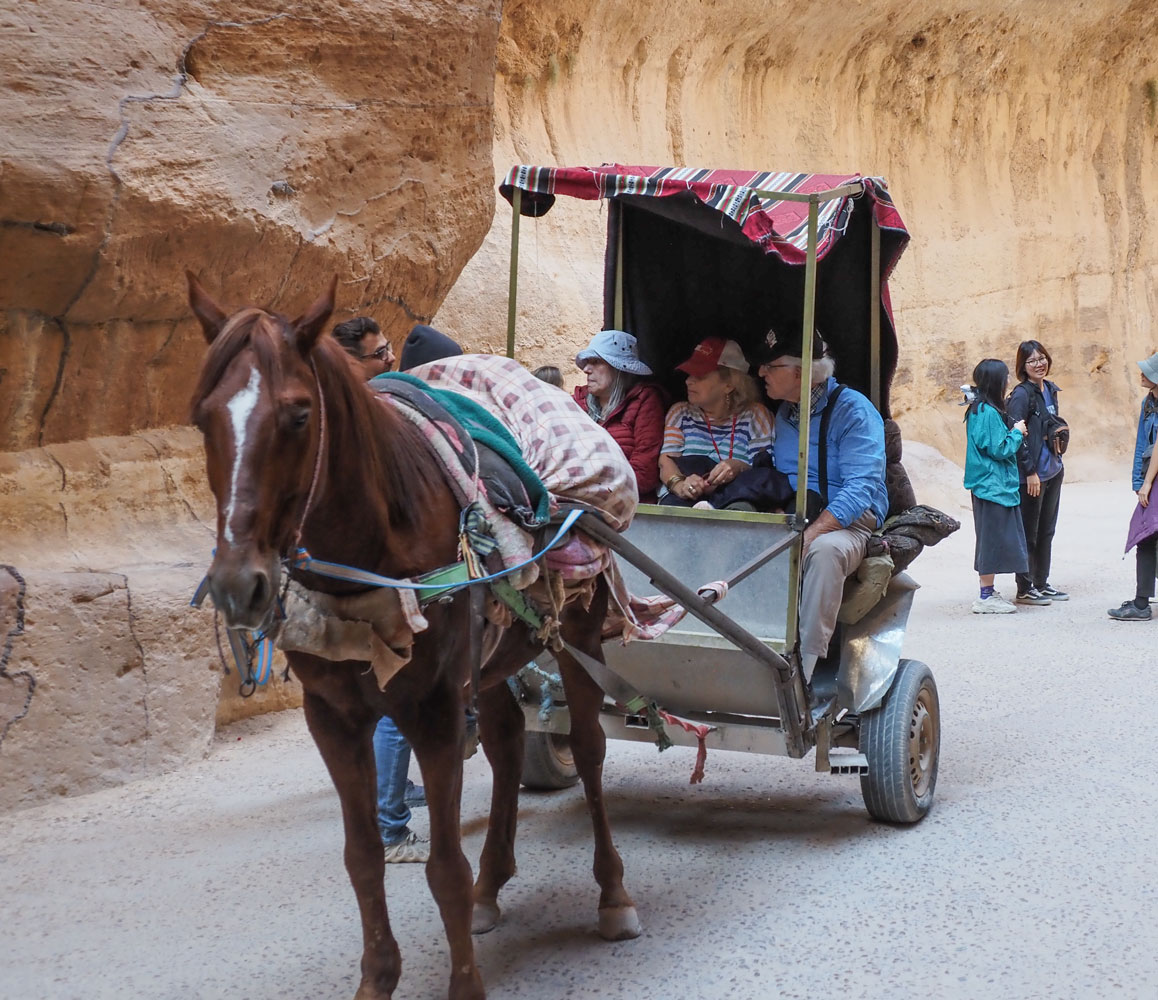
If you take one of those carts, make it clear when you negotiate the price that you will pay half when you get in the cart and the other half when you get out. That way, they will give you the real price (not the cheap price to get you into the cart) and they won't stop half-way. If they do stop and demand more money, just get out and walk. You only paid for half the ride.
A view a bit further along the trail.
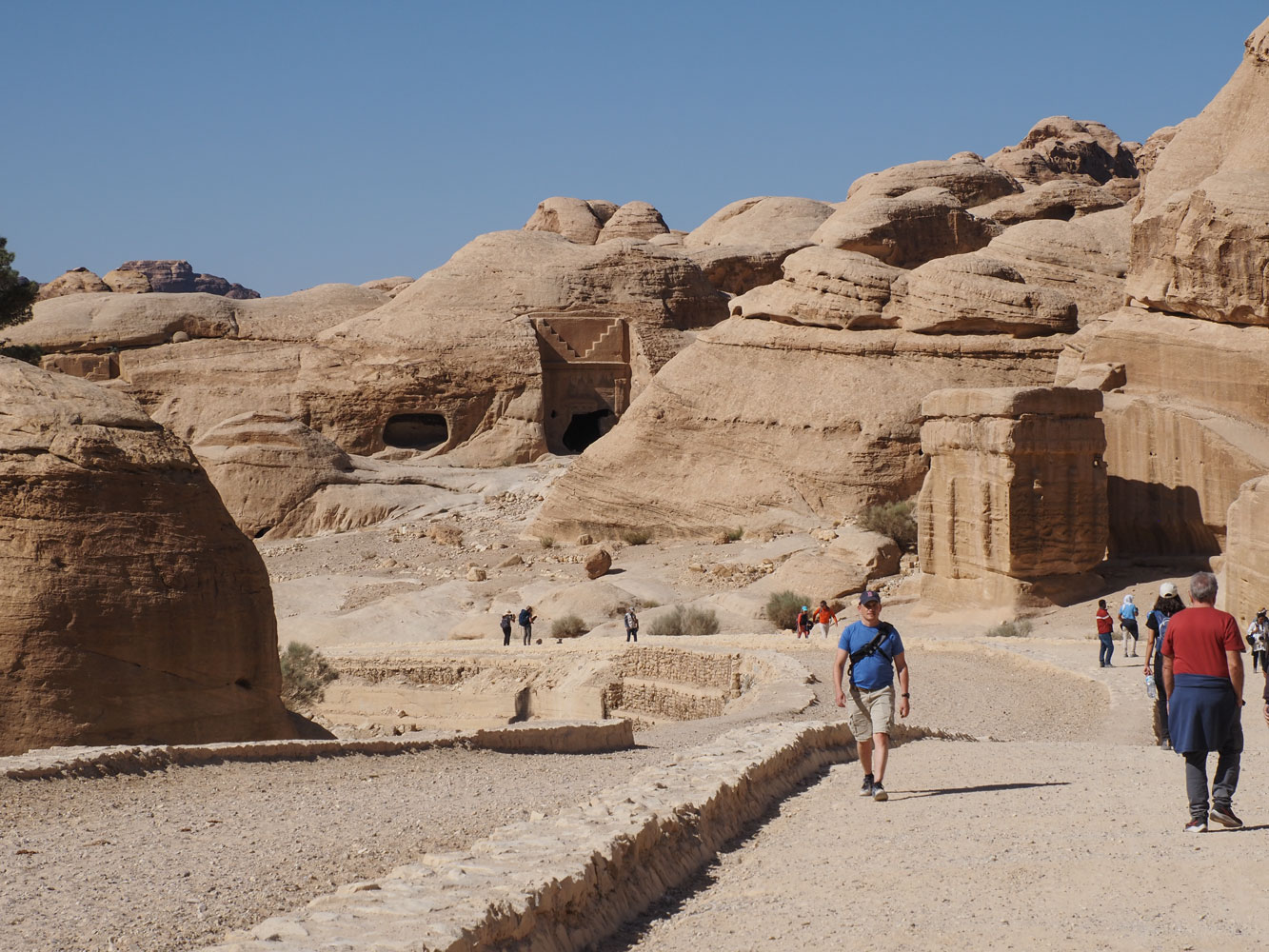
These square blocks were tombs.
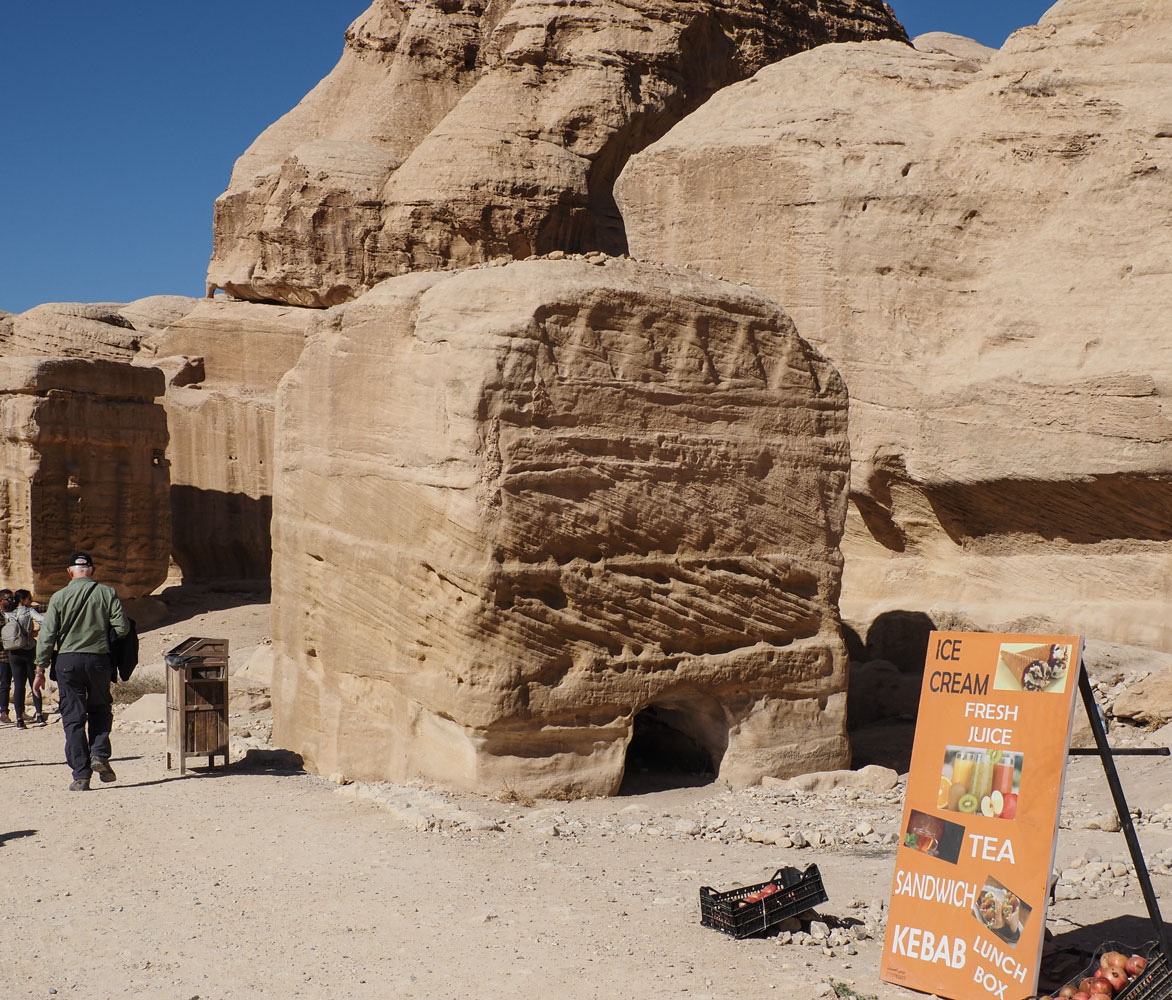
I find the faces of some of the older Arab men to be fascinating. You can see their life written into their faces.
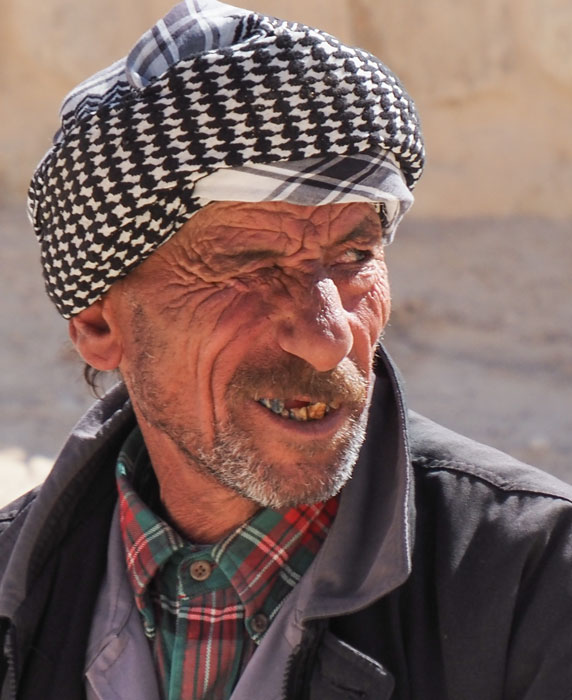
We came upon the Obelisk Tomb and the Bab as-Siq.
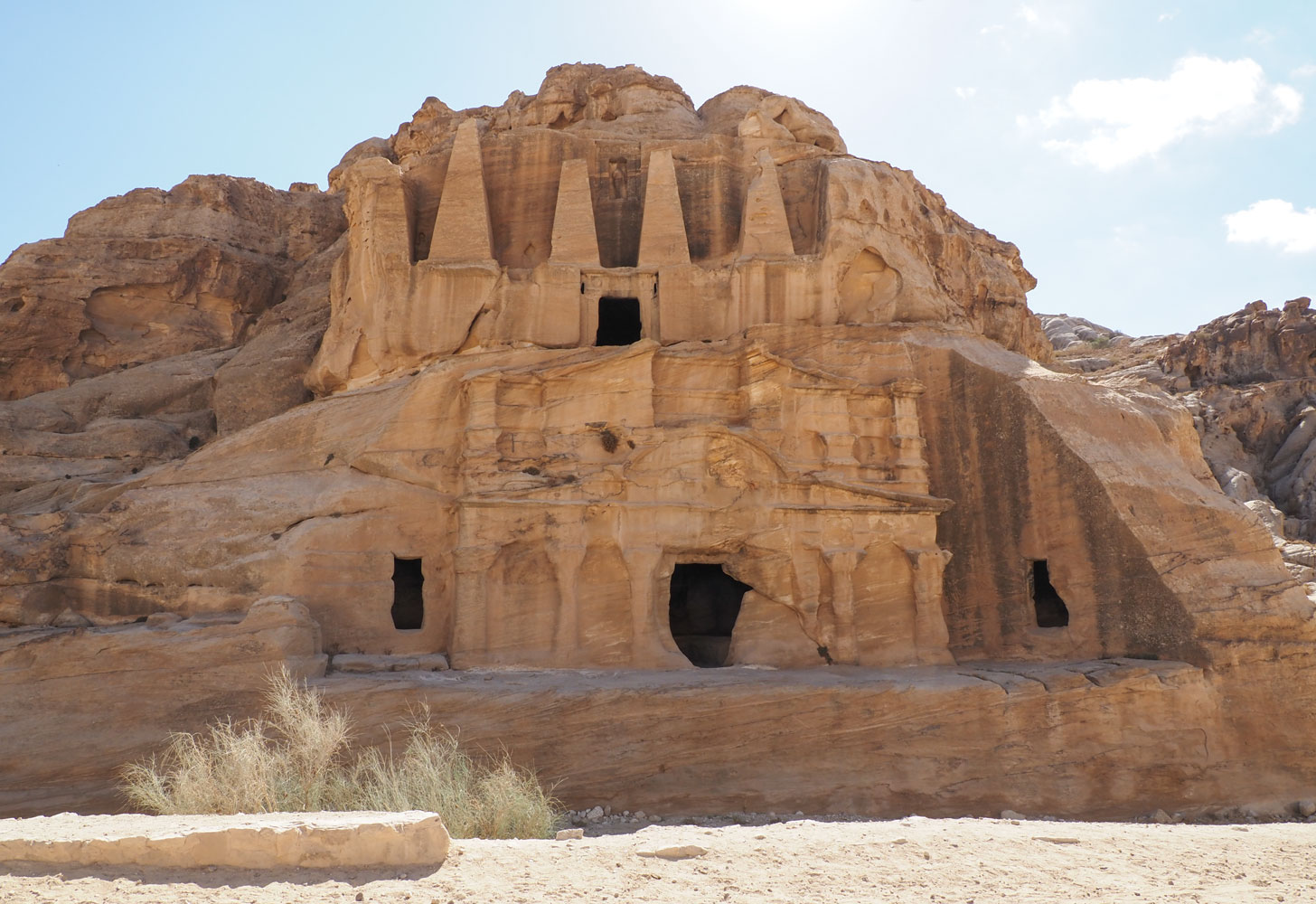
Eventually, we came to the entrance to the Siq. The entrance is fairly well hidden. The term "Siq" is the name of this particular pathway into Petra - it is not a generic term for a trail.
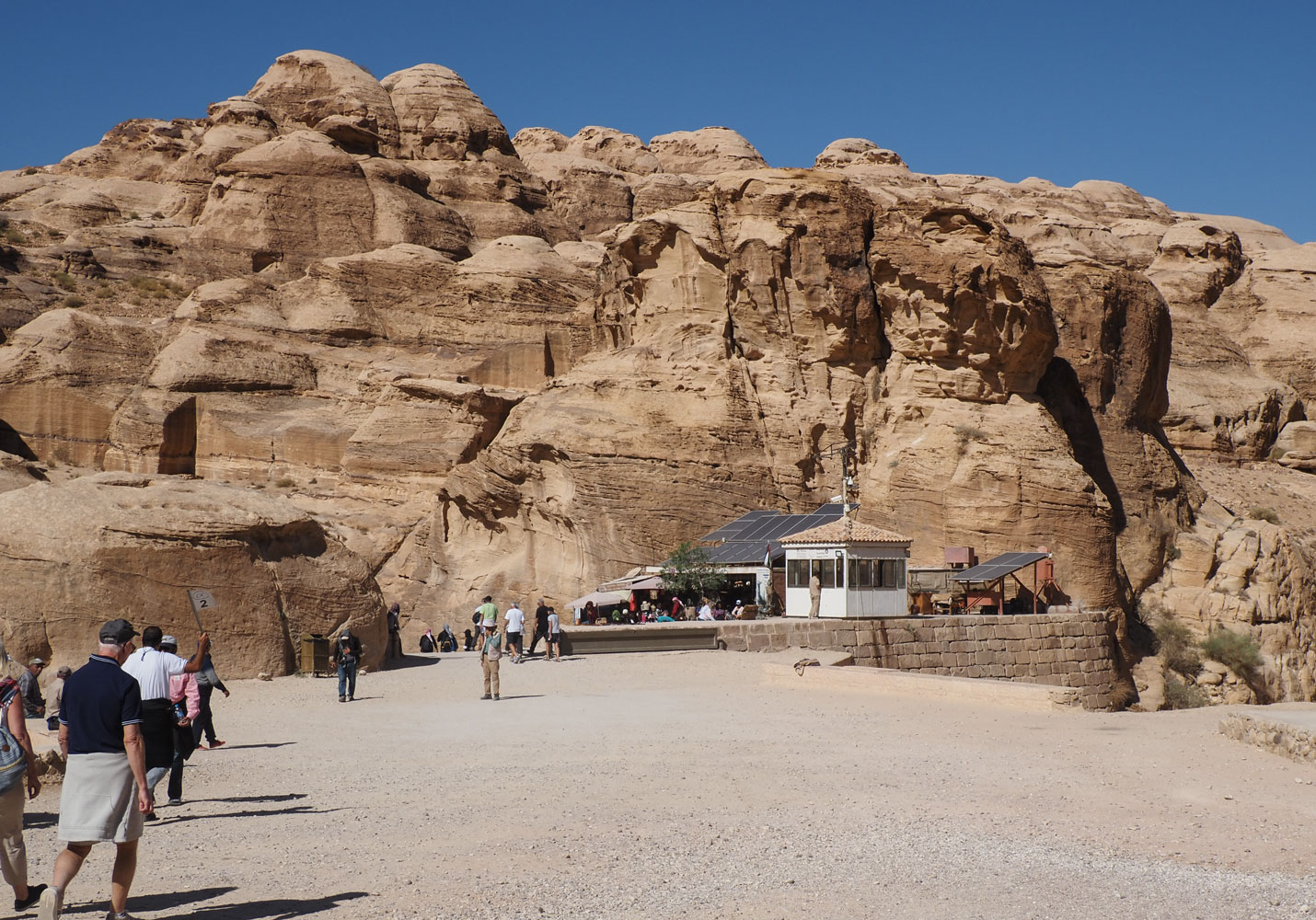
Even when you get closer, it's hard to see the entrance.

At this time, I left the group and headed into the Siq on my own. I felt that I didn't need the explanations provided by the tour guide, and our time in the main part of Petra was limited.
There were two soldiers guarding the entrance to the Siq but they didn't prevent anyone from entering.
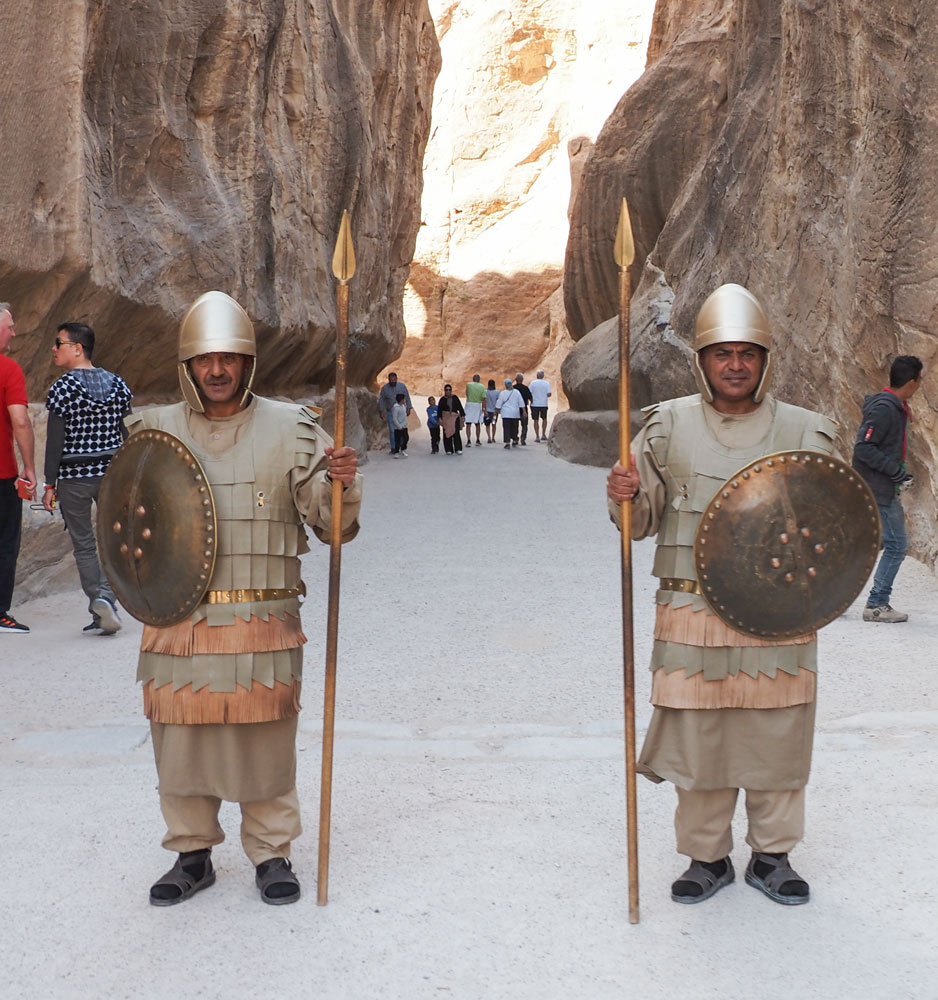
There are some very interesting rock structures as you walk along the Siq.
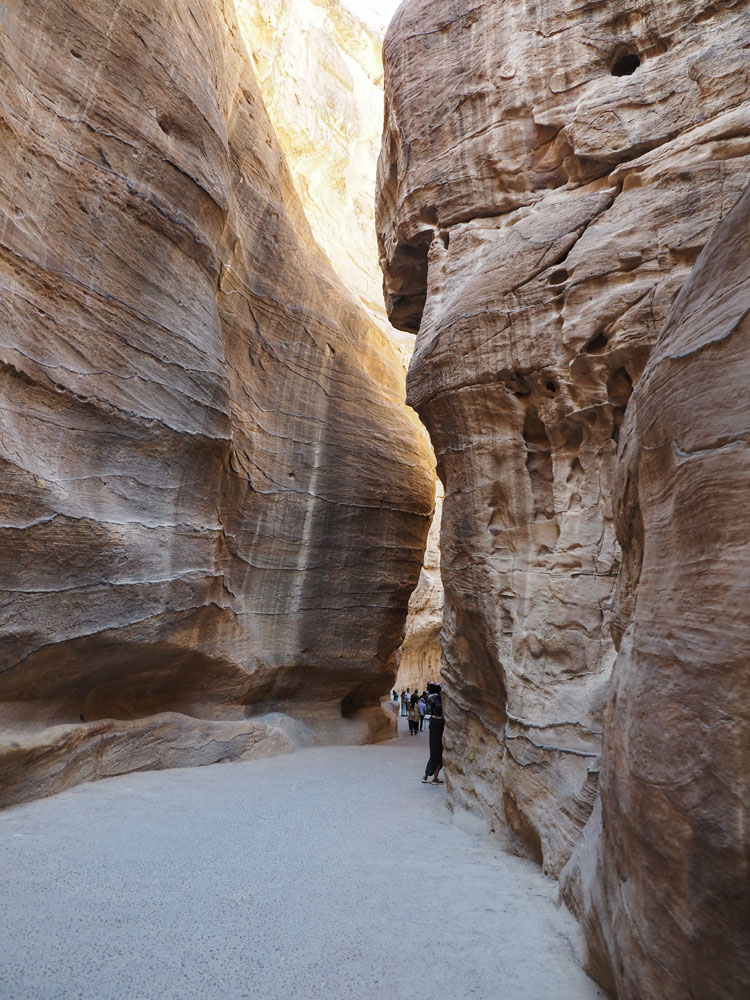
I'll include some pictures of the walk through the Siq.
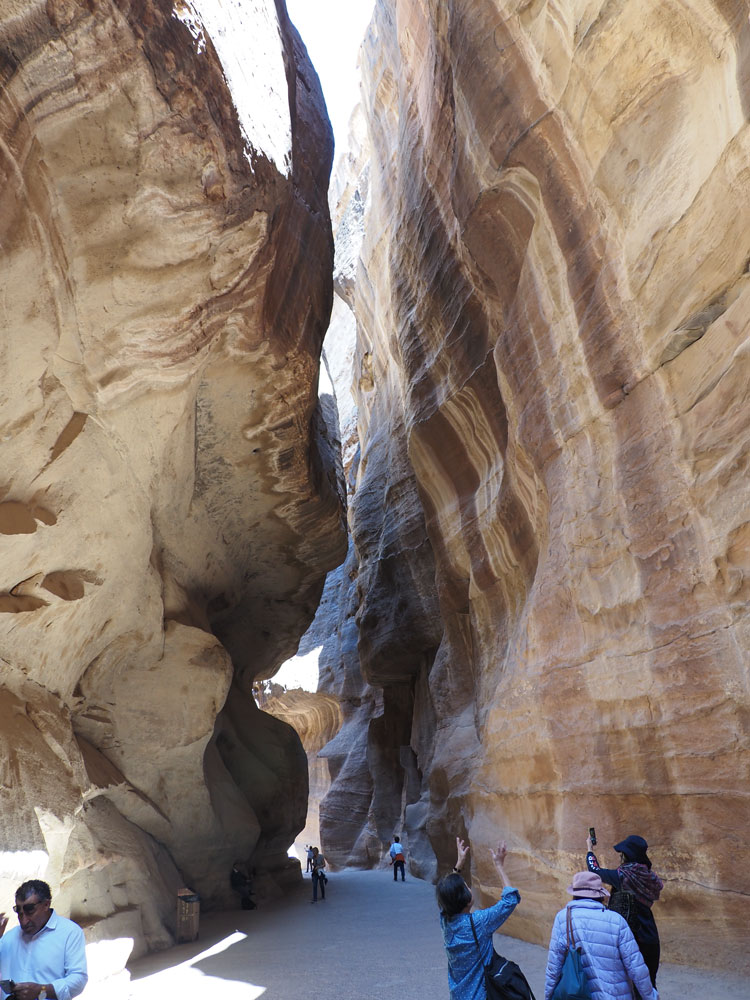
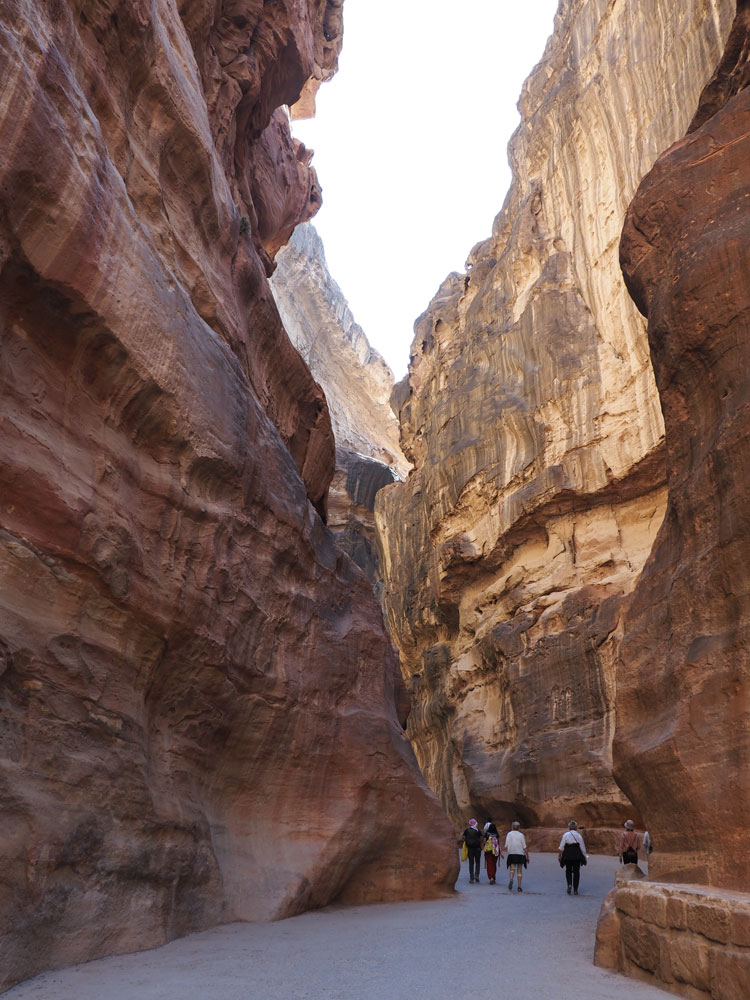
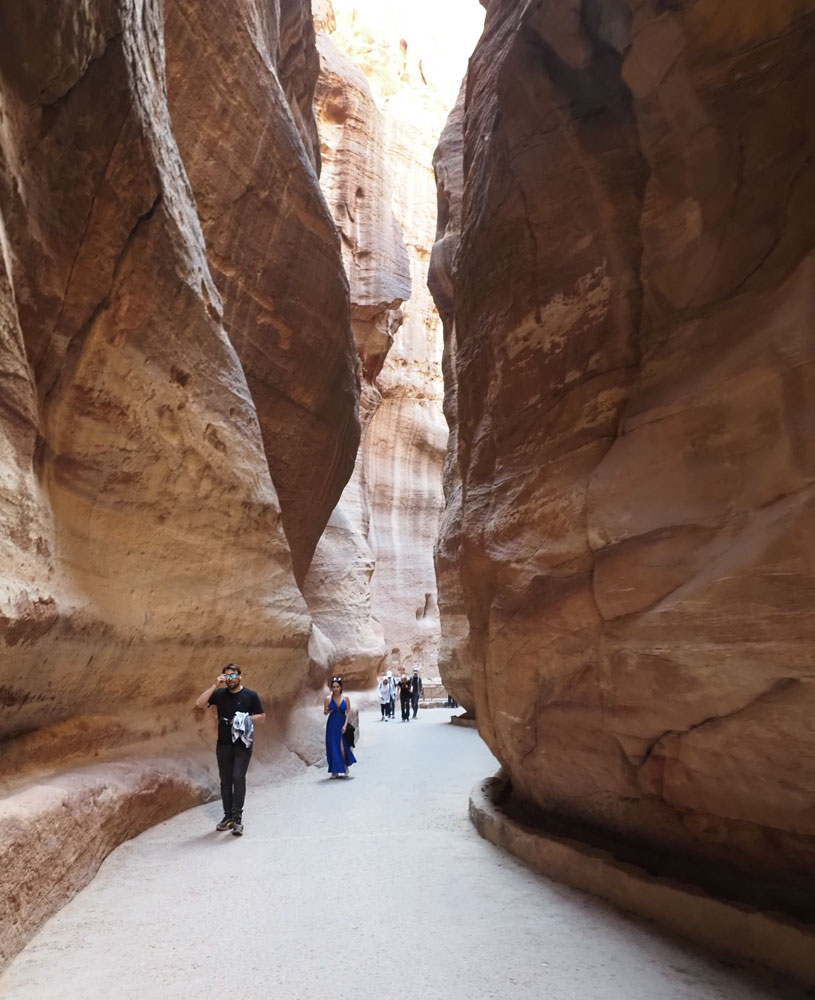
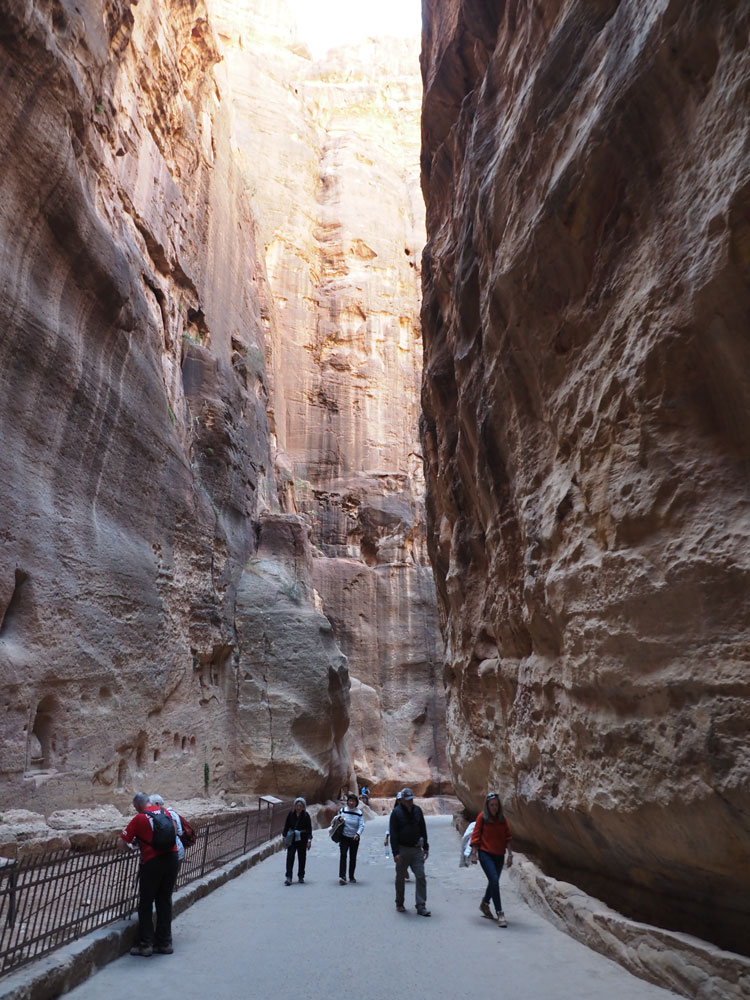
Eventually, you reach the end of the Siq and get a glimpse of the Treasury, known officially as Al-Khazneh. I checked how long the Siq was using my Apple watch - it's 1.2km.
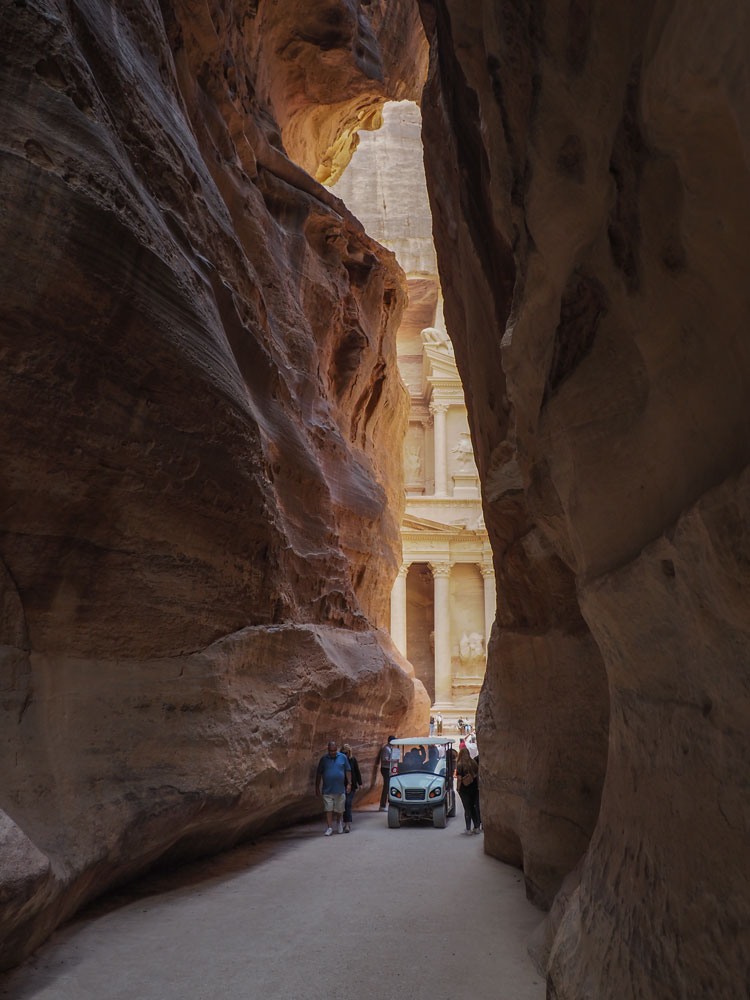
A full view of the Treasury.
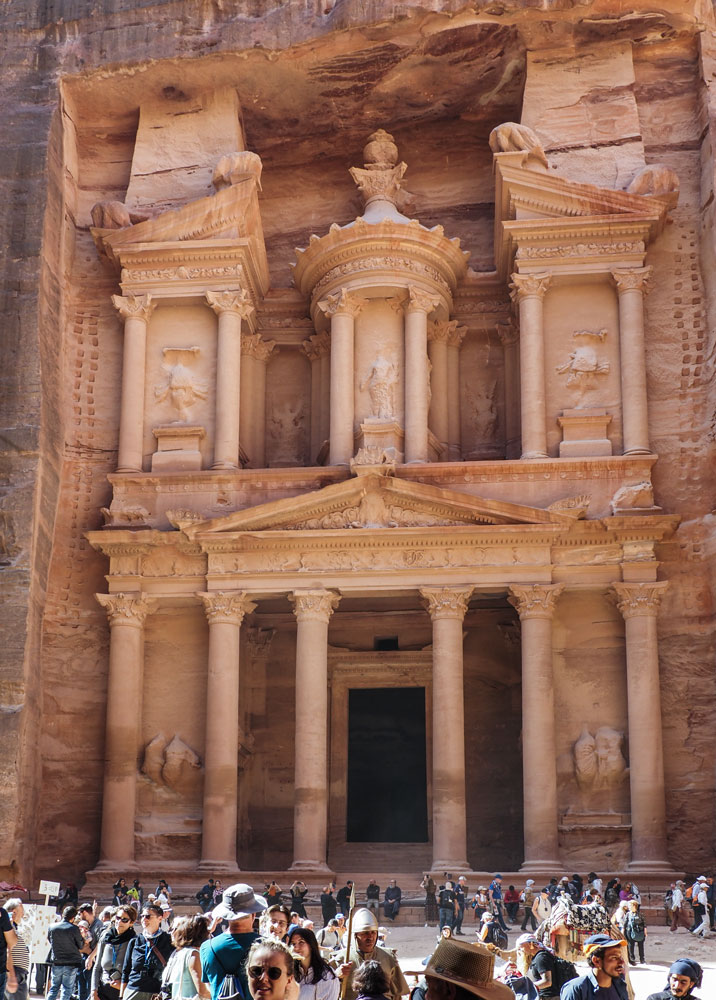
A view from the base.
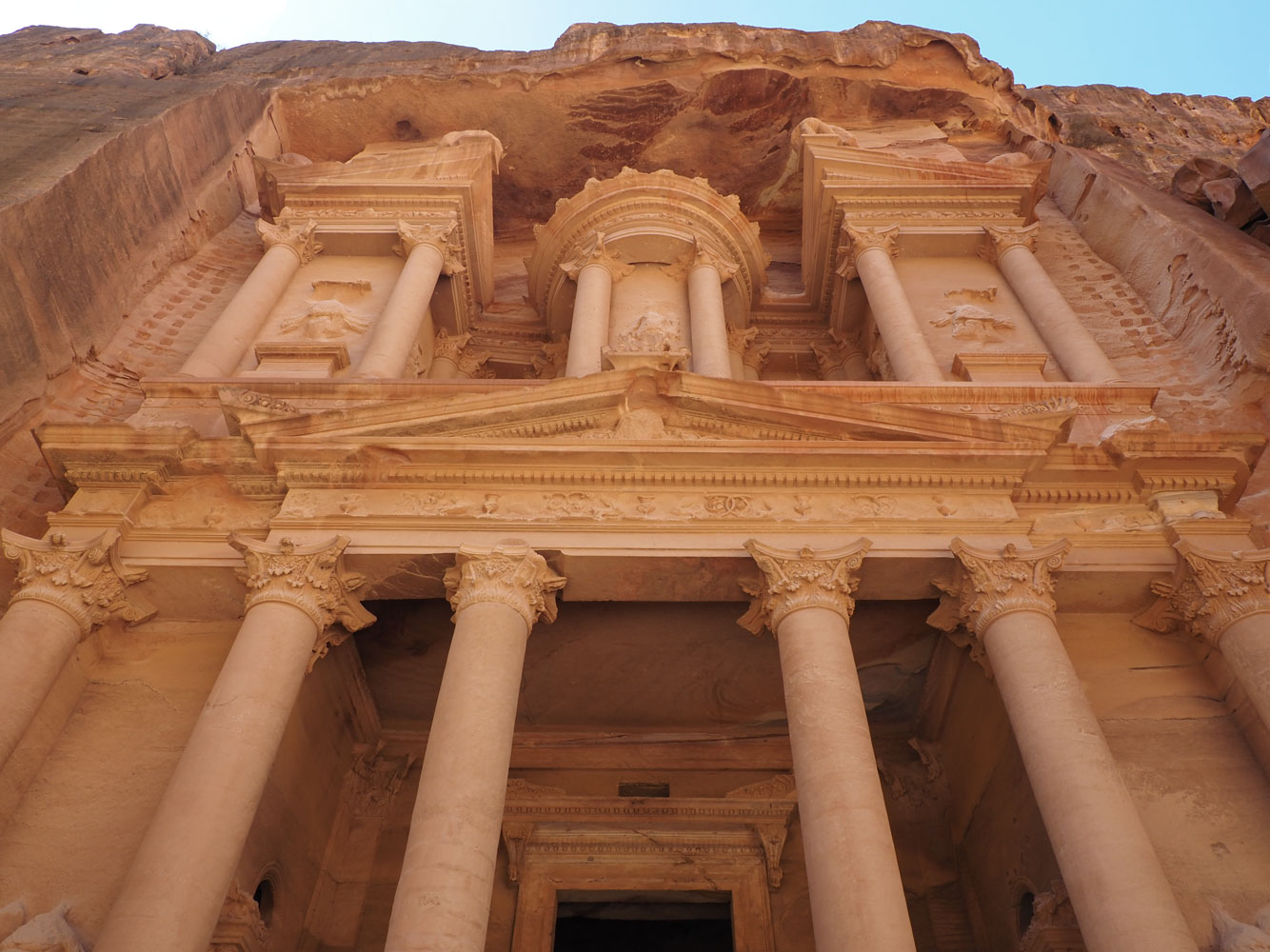
Heading further into Petra, you see other, less elaborate, tombs.
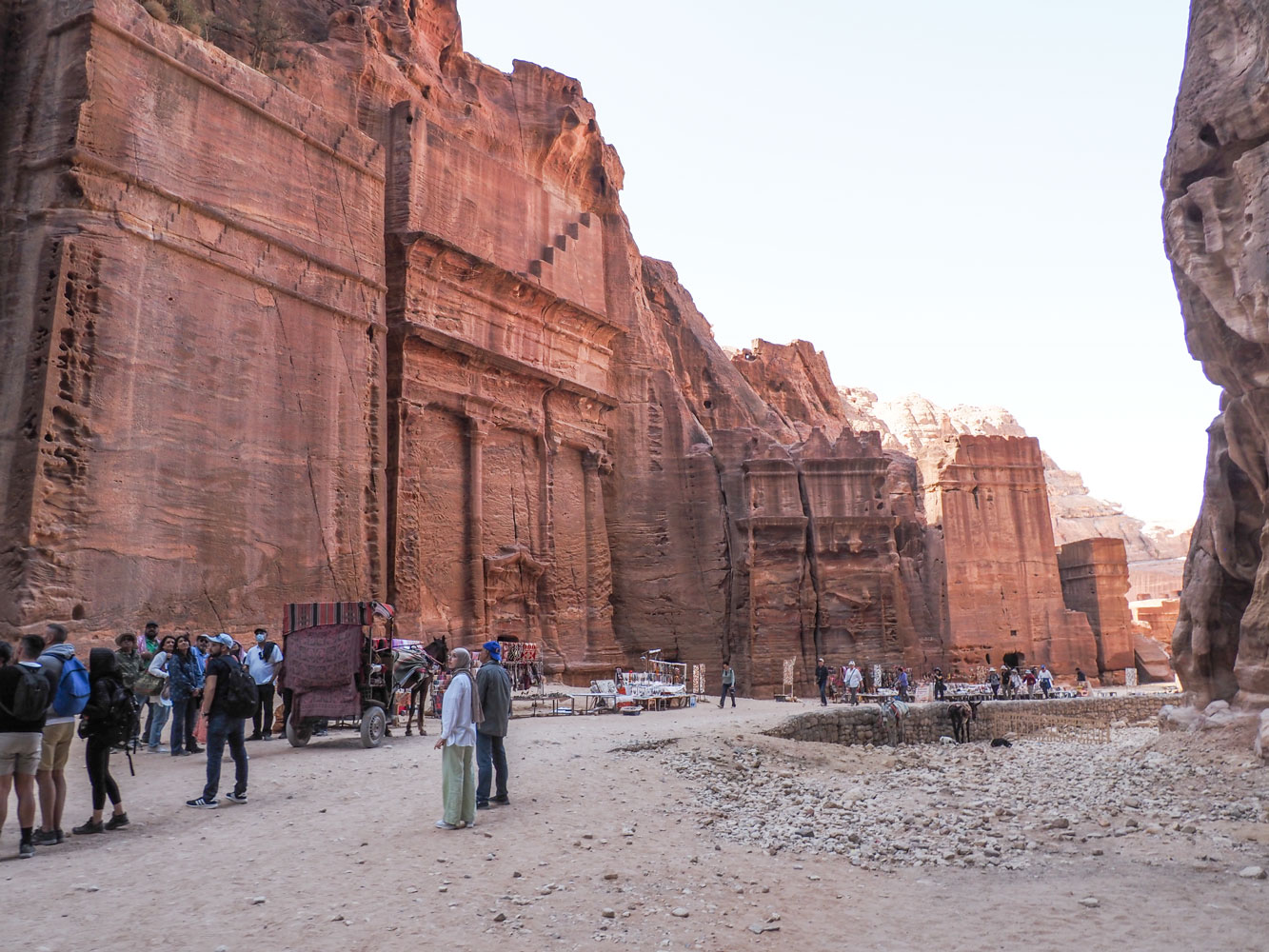
This row of tombs is near the theatre.
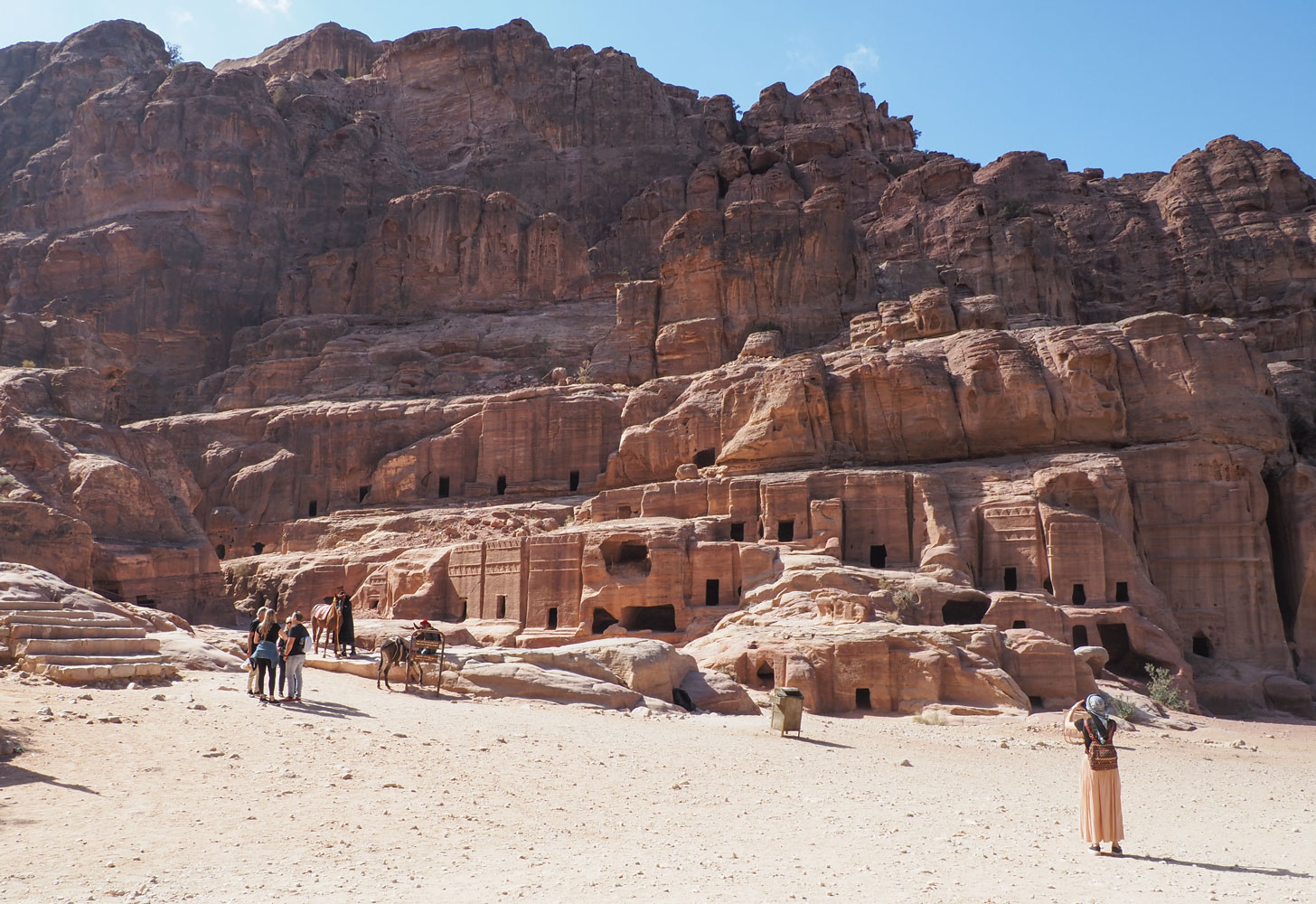
And the theatre.

A short distance further on is the Royal Tomb of Malchus, also known as the Urn Tomb. It is built up on the hillside and is the first of a group of "Royal Tombs" at that level. There are steps to get up there.

I took this picture when I was about half way up, because you can see more of the tomb area from here.
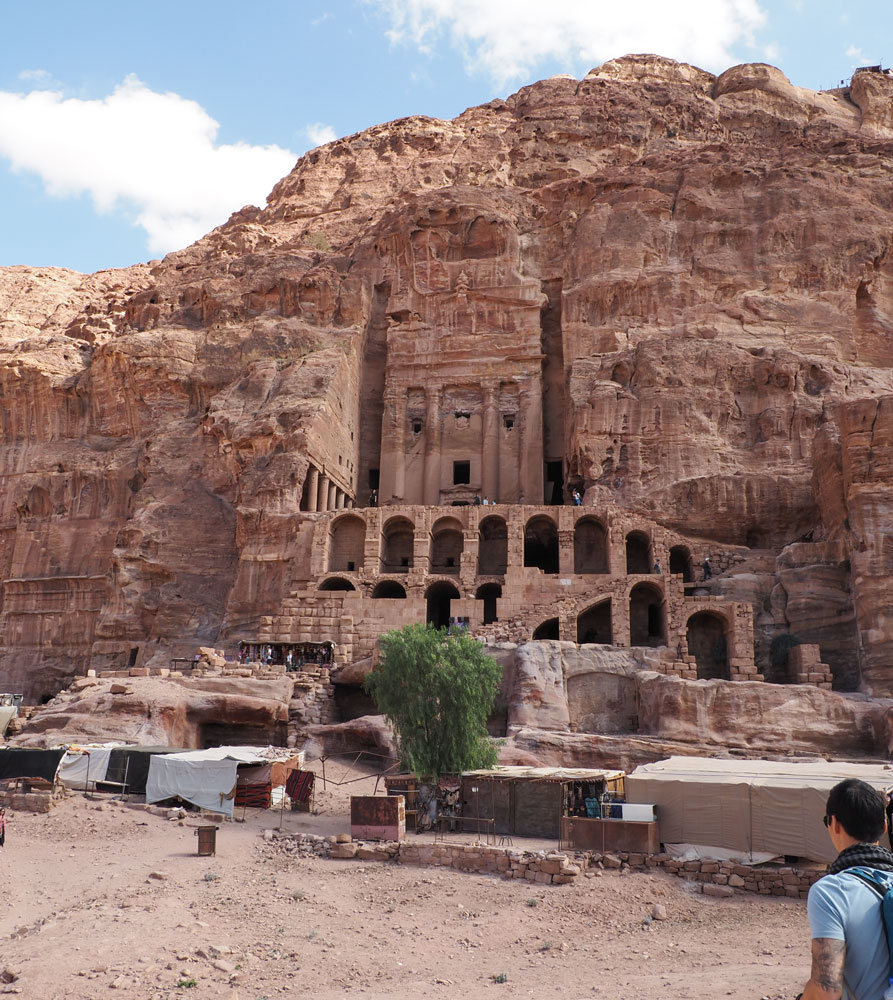
There's a great view of the valley from the tomb.
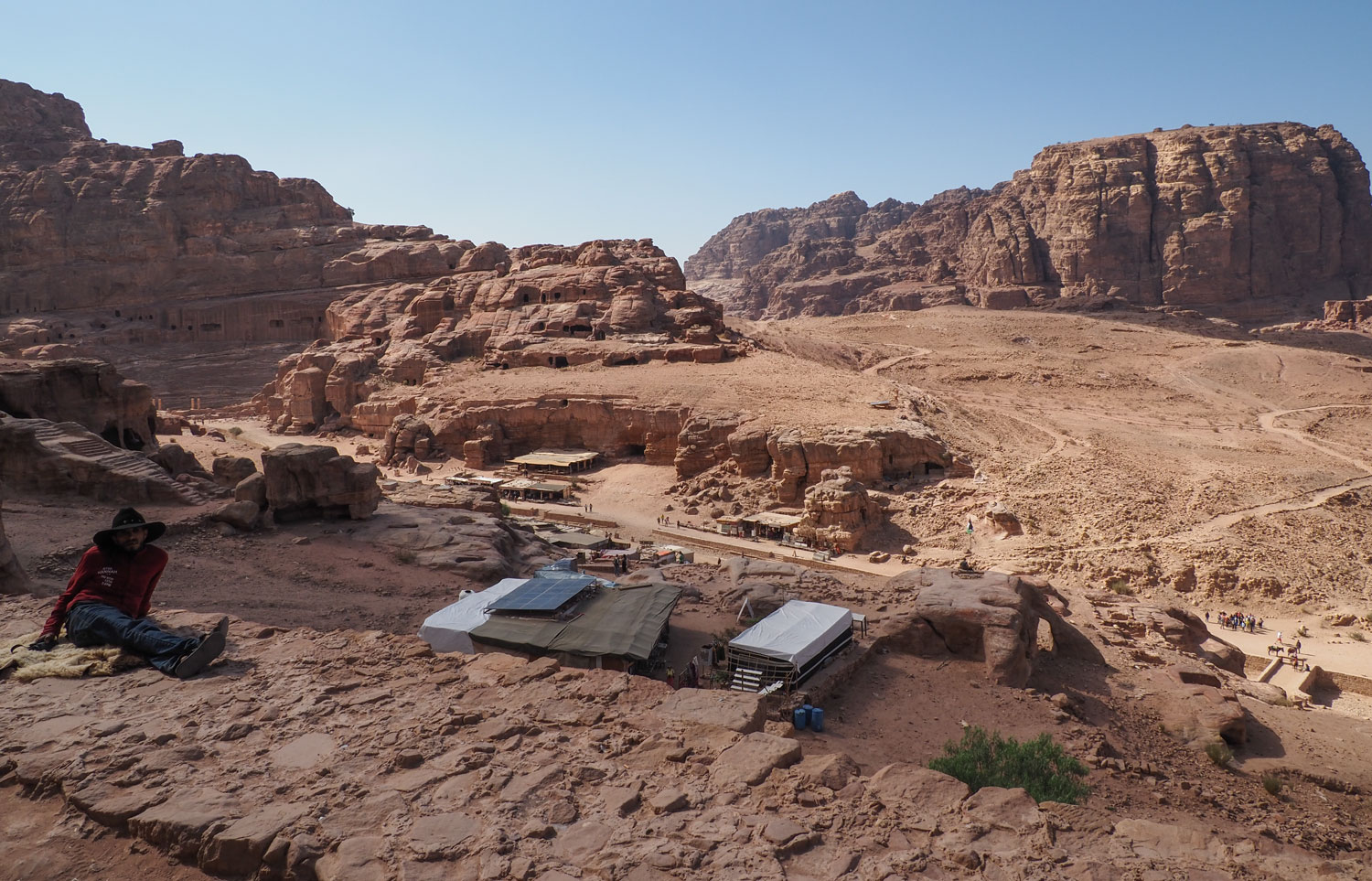
A view of the tomb from directly in front of it.

I asked someone to use my camera and take a picture of me, to show I was there.
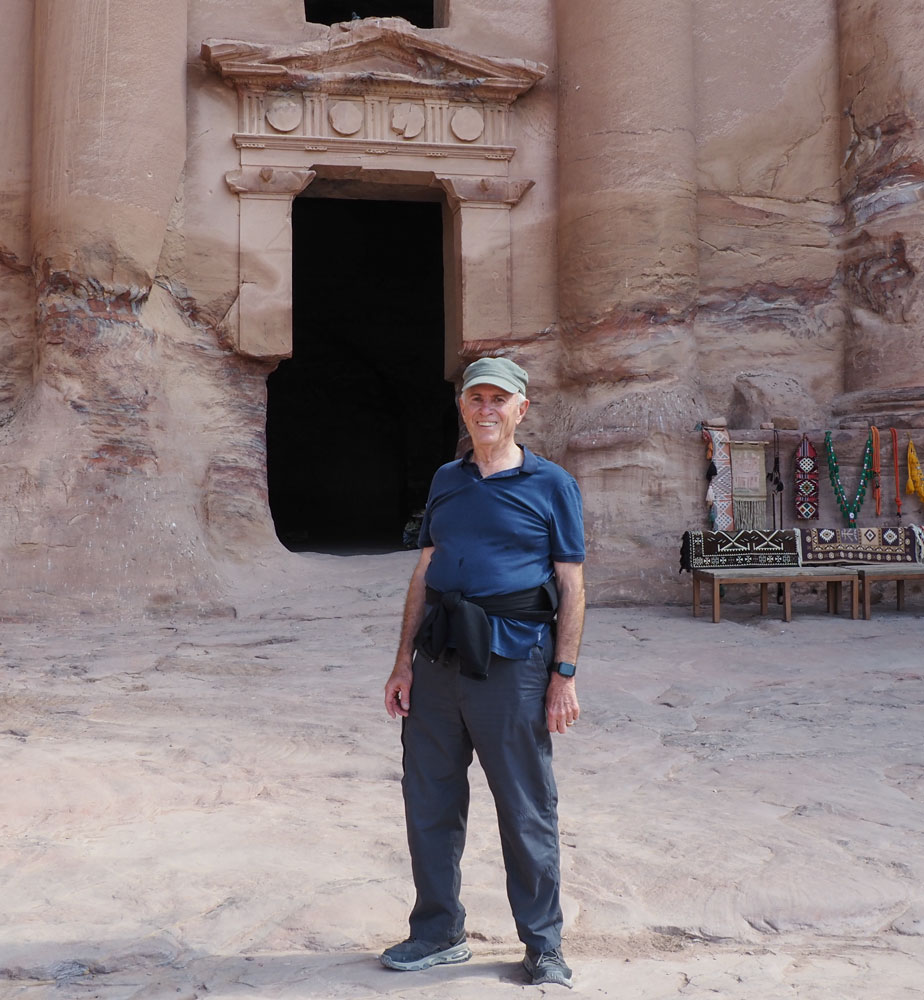
A view further down the main valley. I didn't have time to get there. There are some Roman columns from a structure the Romans built while they occupied Petra.

I didn't have time to get to it, but the Monastery (Ad-Deir, or Ed-Deir) is perhaps the second most famous building in Patra, after the Treasury (Khazneh). Here's a picture of it from the web. It takes some time and effort to get to it.

Some of the other Royal Tombs, on the same level as the Urn Tomb, but I did not have time to go over to them. By the time I got down, it was about time for me to go. I have to meet the rest of the group at 2pm for lunch.
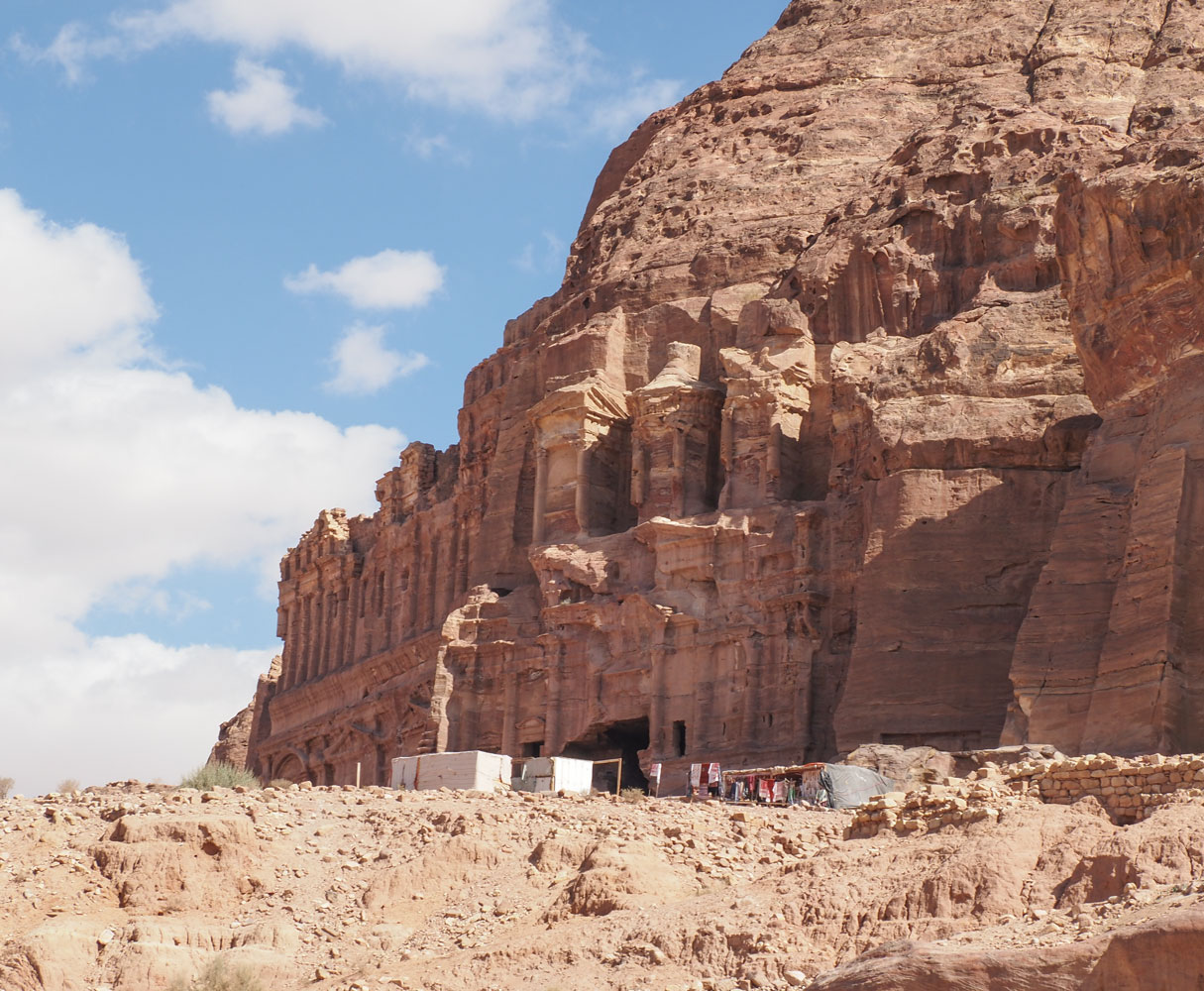
A couple of Siq pictures on the way back.
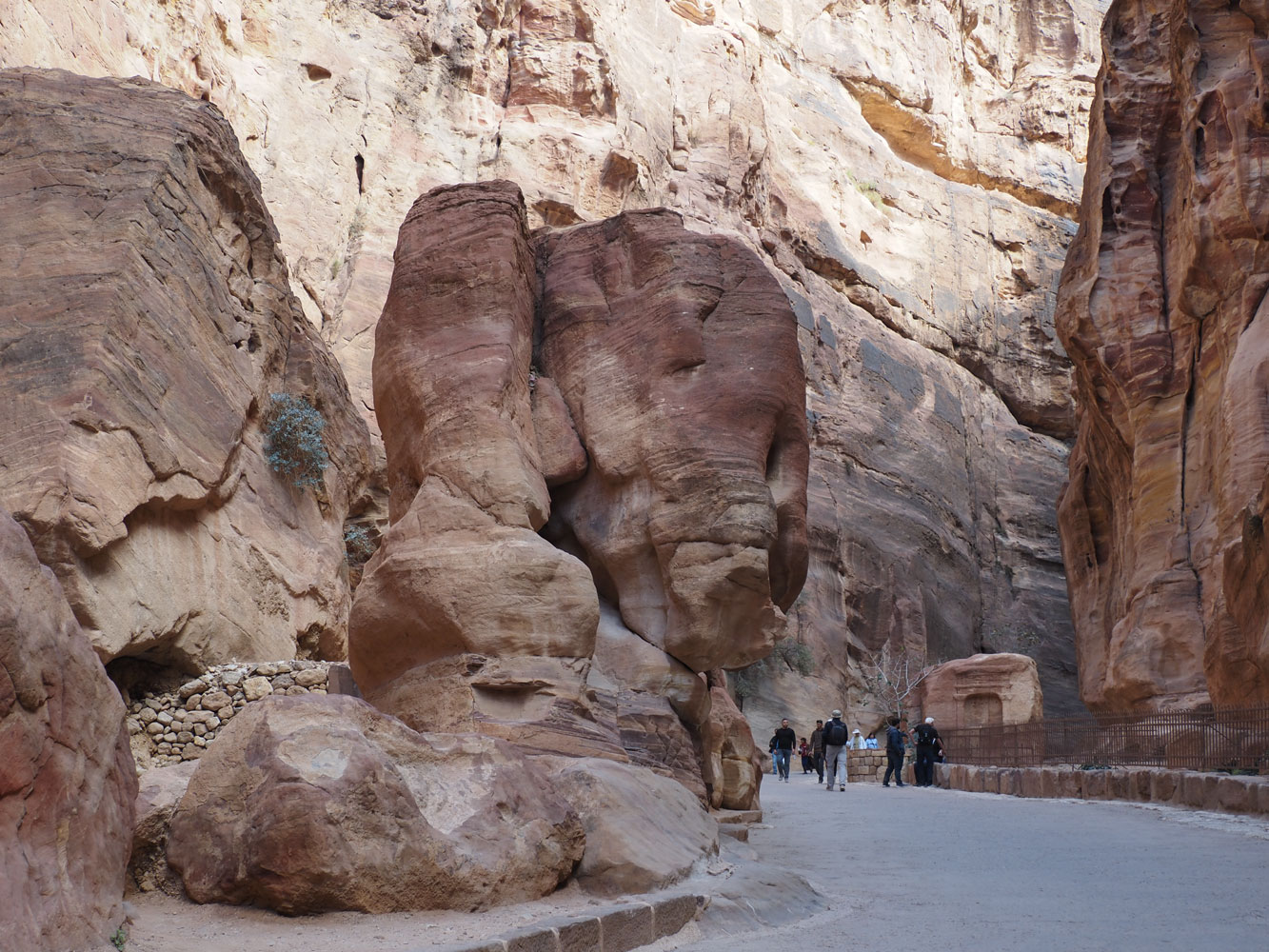
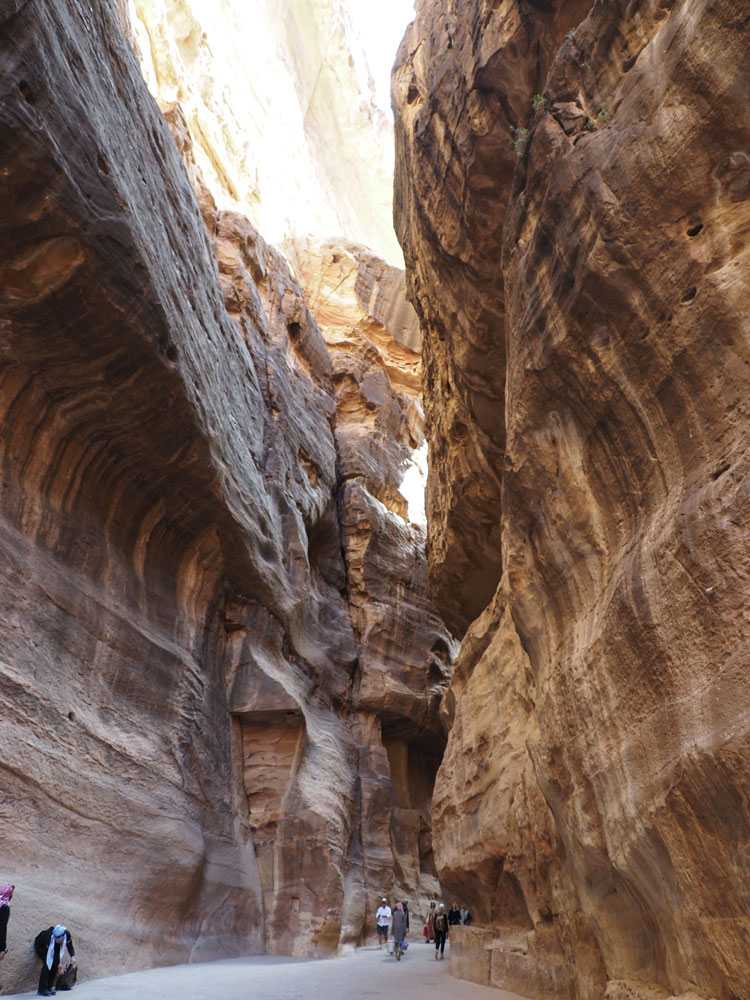
It was definitely a tougher walk back, but I was moving fairly fast. I made it back in time for lunch, and then I walked to the museum, but did not have time to visit.
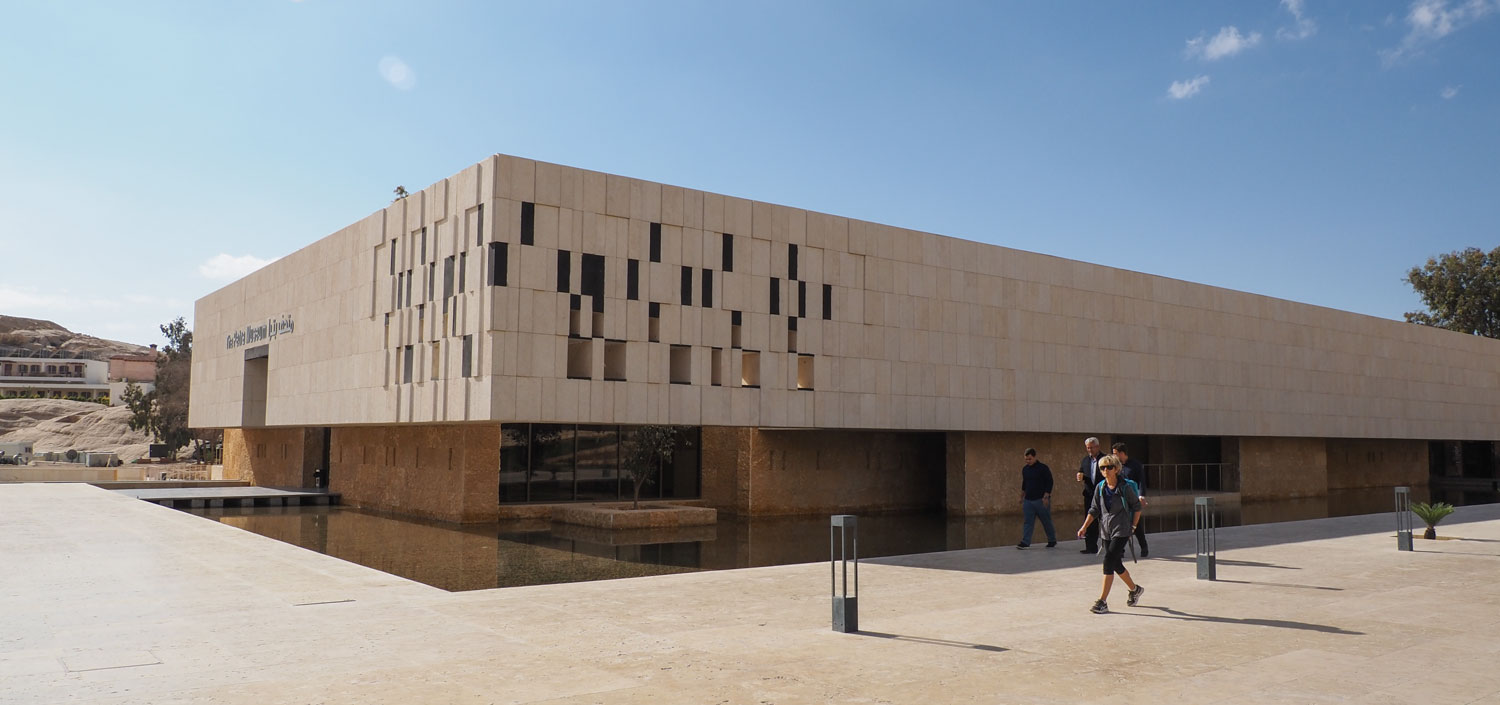
We boarded the bus for the trip to Wadi Rum, a two-hour drive.
Along the way, we stopped at a souvenir shop for a bathroom break. They had a display of Frankincense and Myrrh. I bought a Myrrh product for Judy, a compressed aromatic bar.

Eventually, we arrived at Wadi Rum. The sun was low in the sky by the time we arrived.
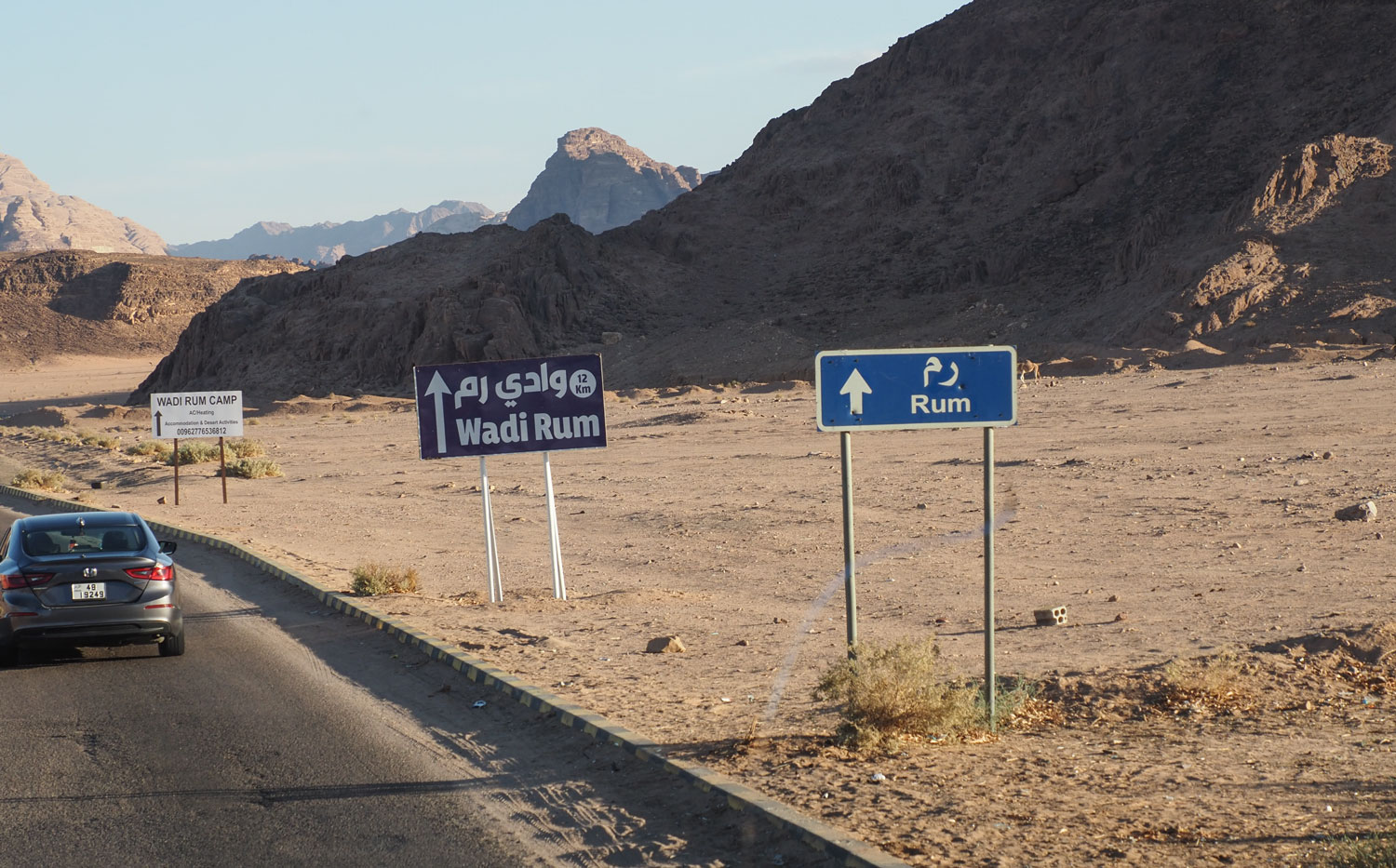
We went first to the reception area. In the background of this picture is the Seven Pillars Mountain, named after T.E. Lawrence's (Lawrence of Arabia) book, "The Seven Pillars of Wisdom," which, incidentally is a very good read.
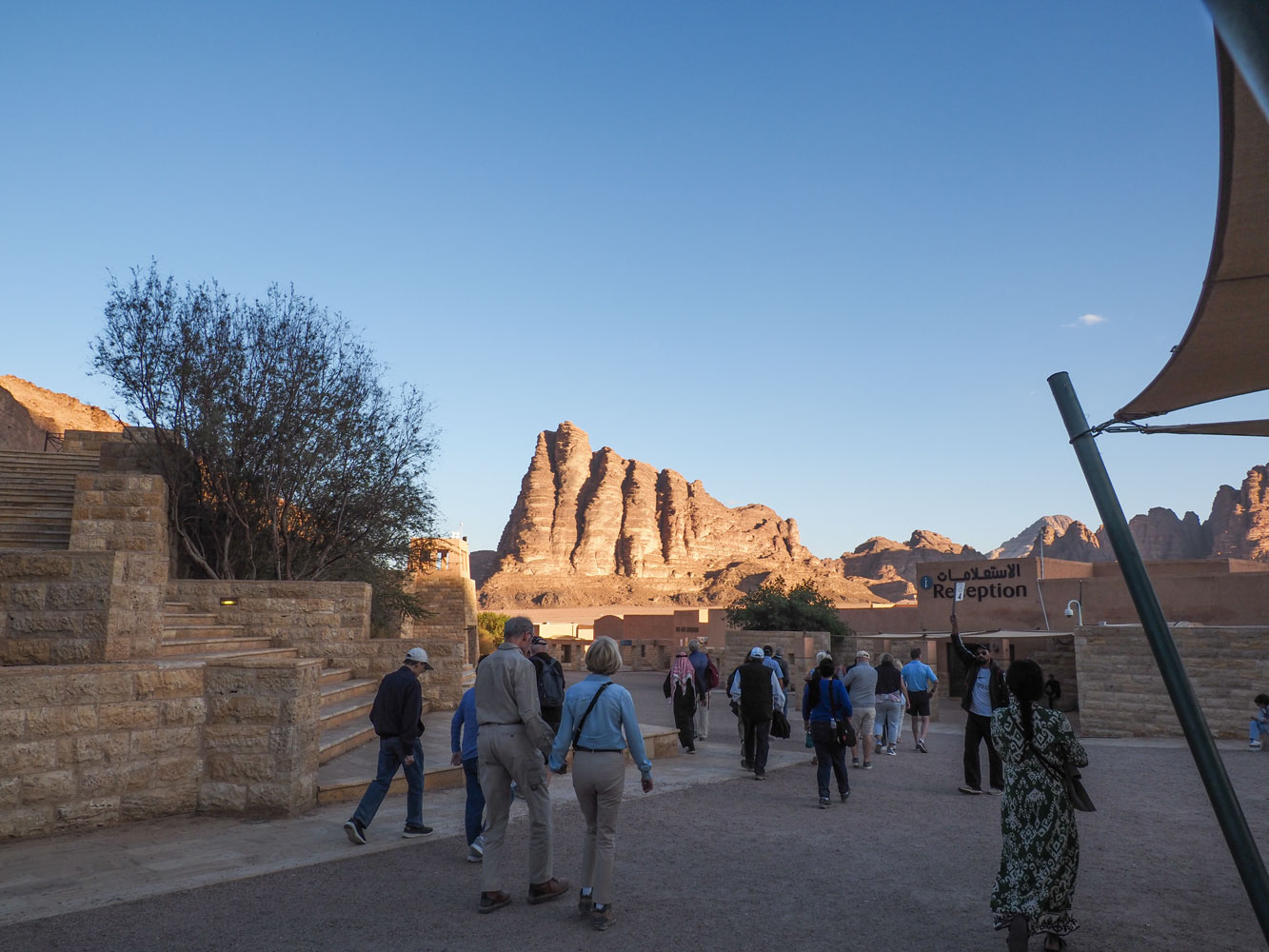
From the Reception area we went to an area where they had a bunch of trucks. They call these "jeeps" but they're just small pickups with a bench seat on each side of the truck bed.
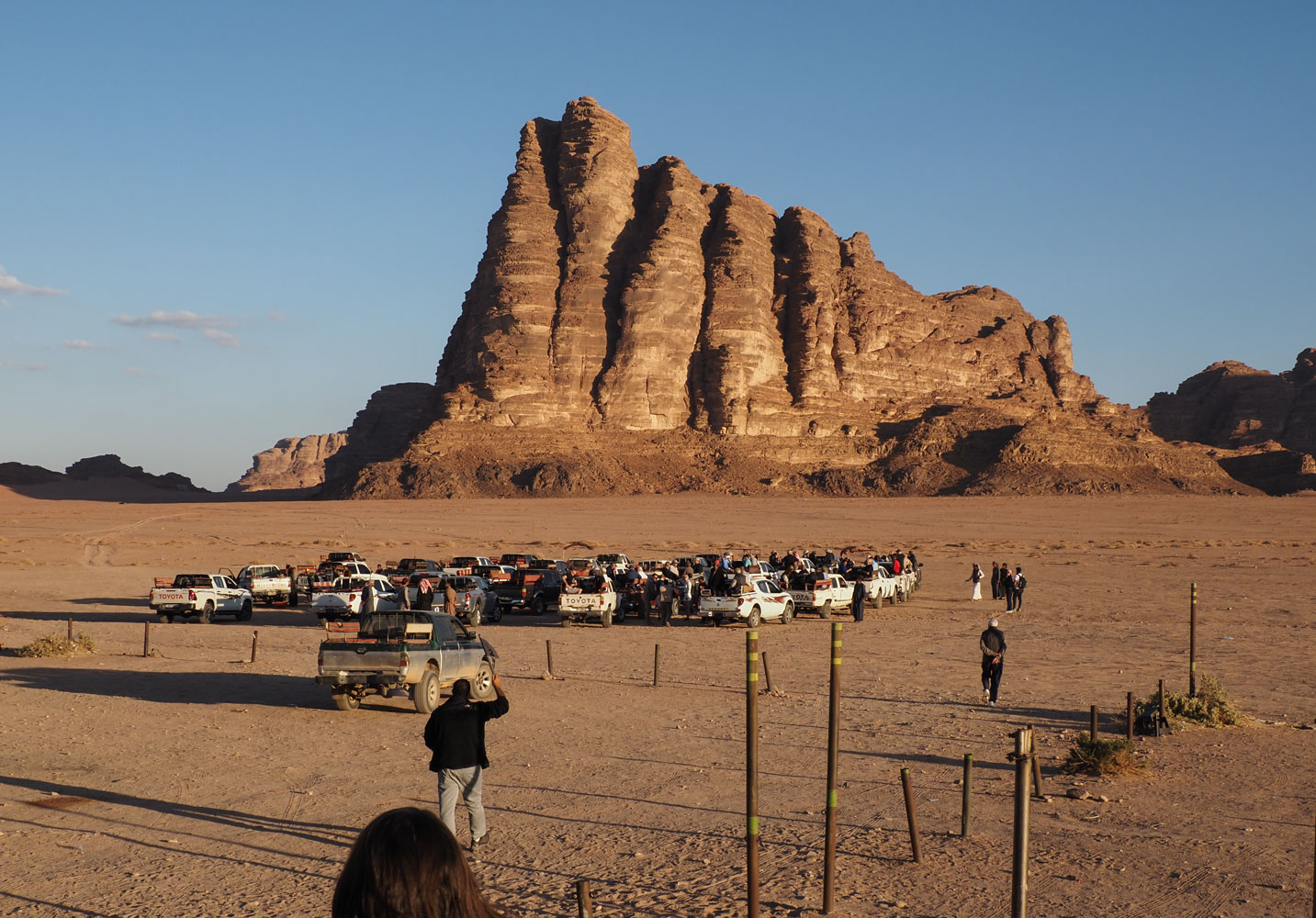
The put six people in each truck. It was pretty difficult to get into the truck, especially for some of the mobility-limited guests. We all had to get over the tailgate to get into the truck.
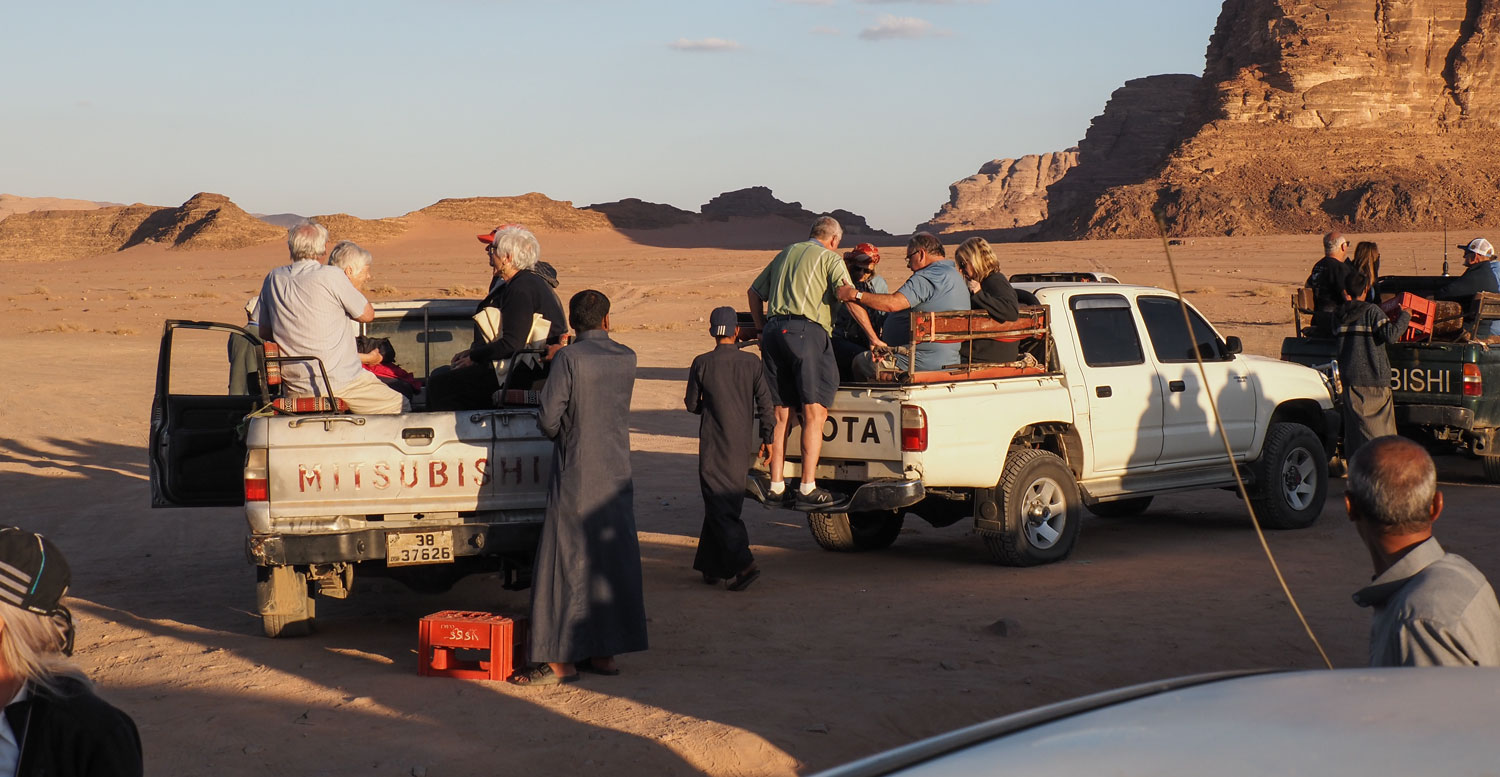
And then we headed out into the desert. You can see that there's almost no vegetation in Wadi Rum. It's just sand and some rock outcroppings.
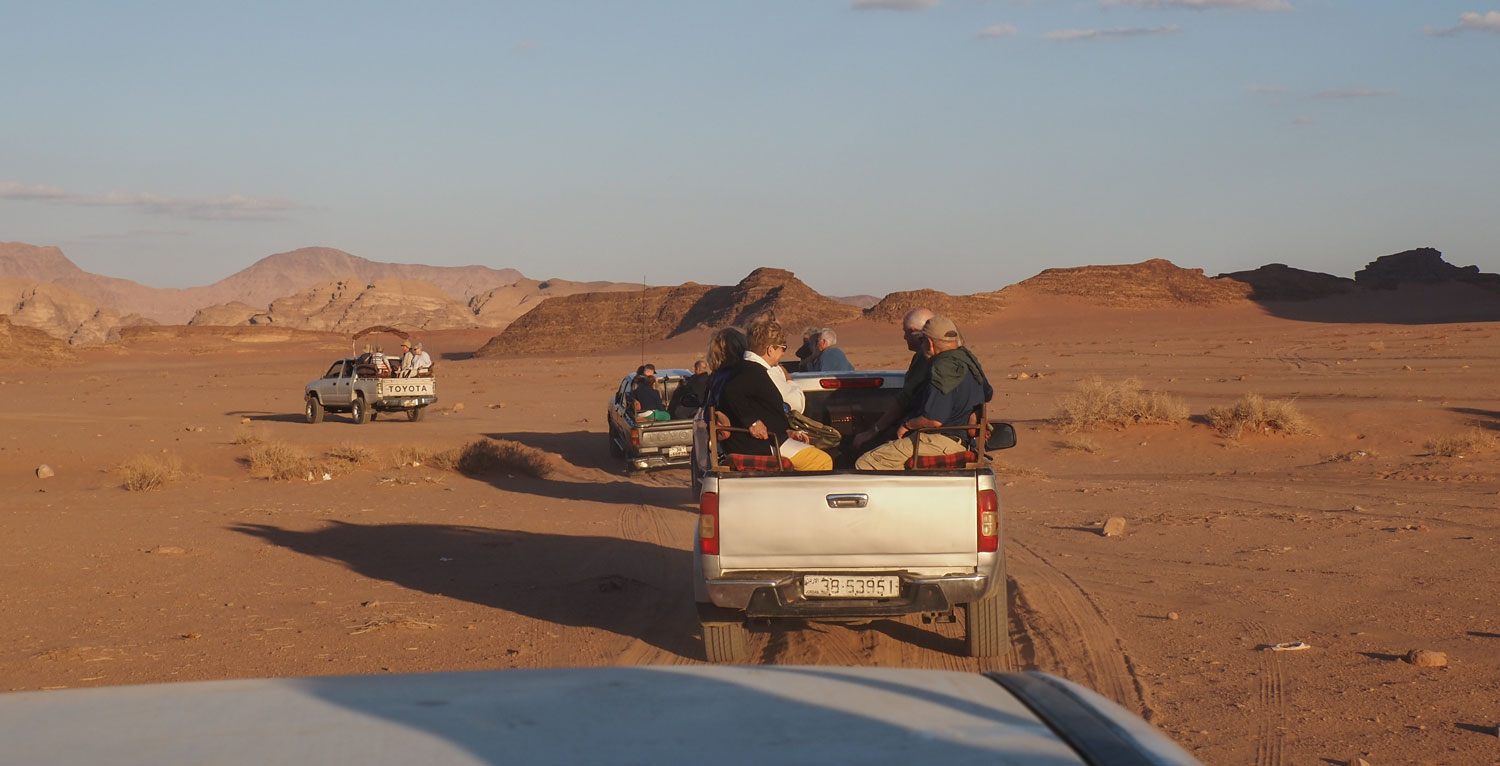
The took us to a large rock outcrop to view the sunset. I didn't change the color of these next few pictures, to show the sunset color.
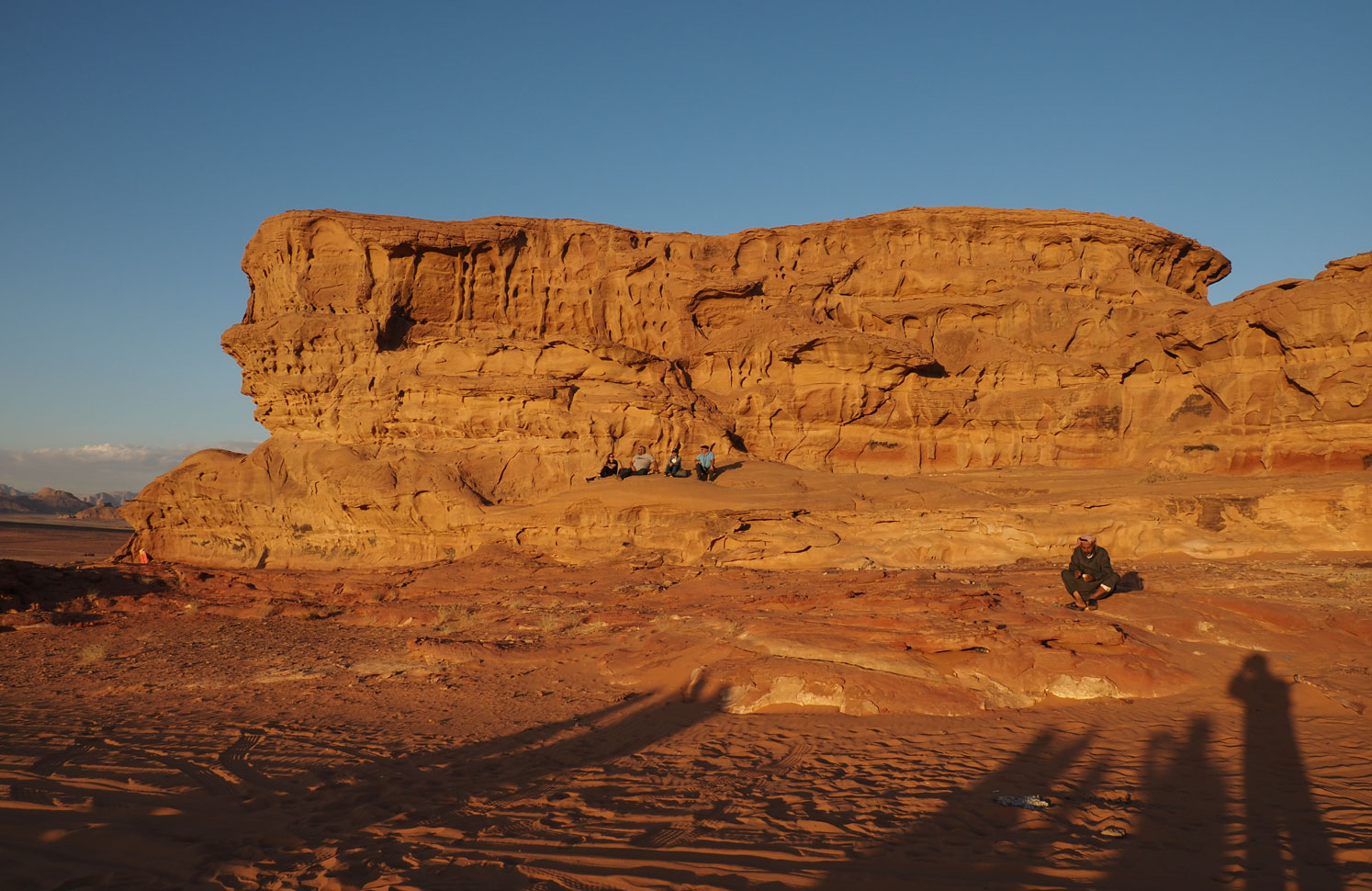
Here I am at that area.
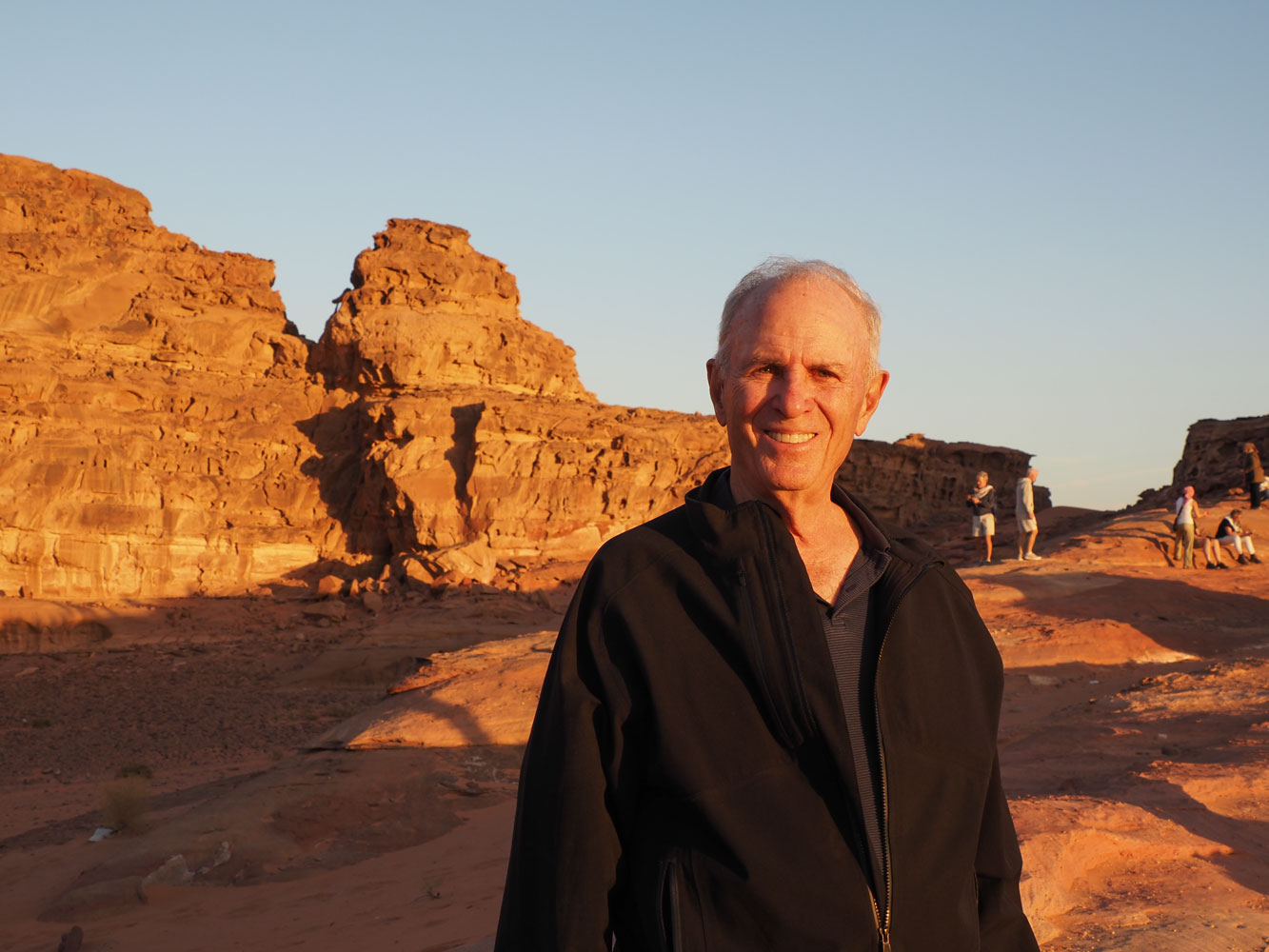
Finally, the sun did set.
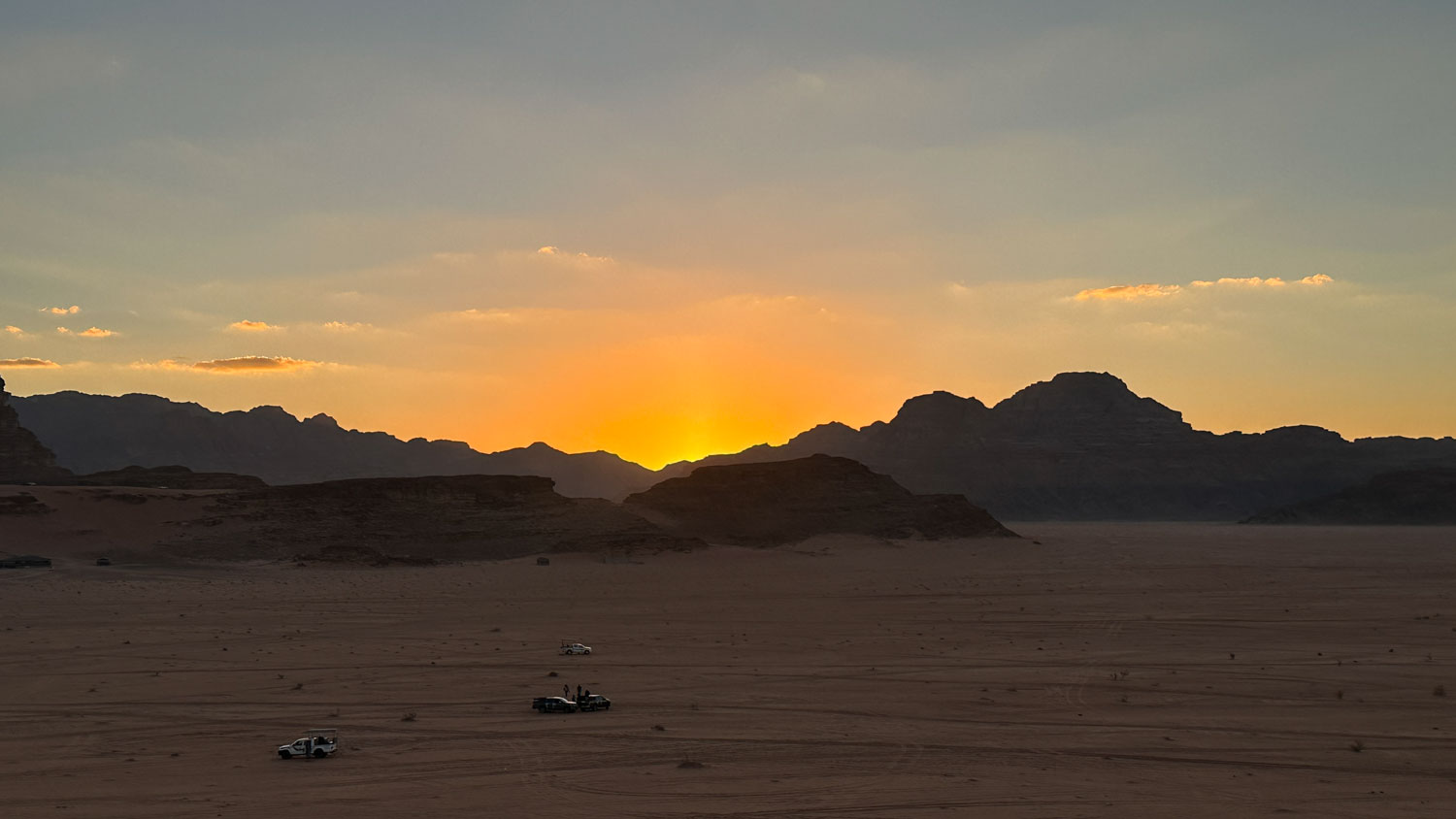
We got back into the trucks and they took us to a "camp" site. It was starting to get fairly dark now, but the camera has the ability to take pictures in very low light so it looks brighter in the pictures than it really was.
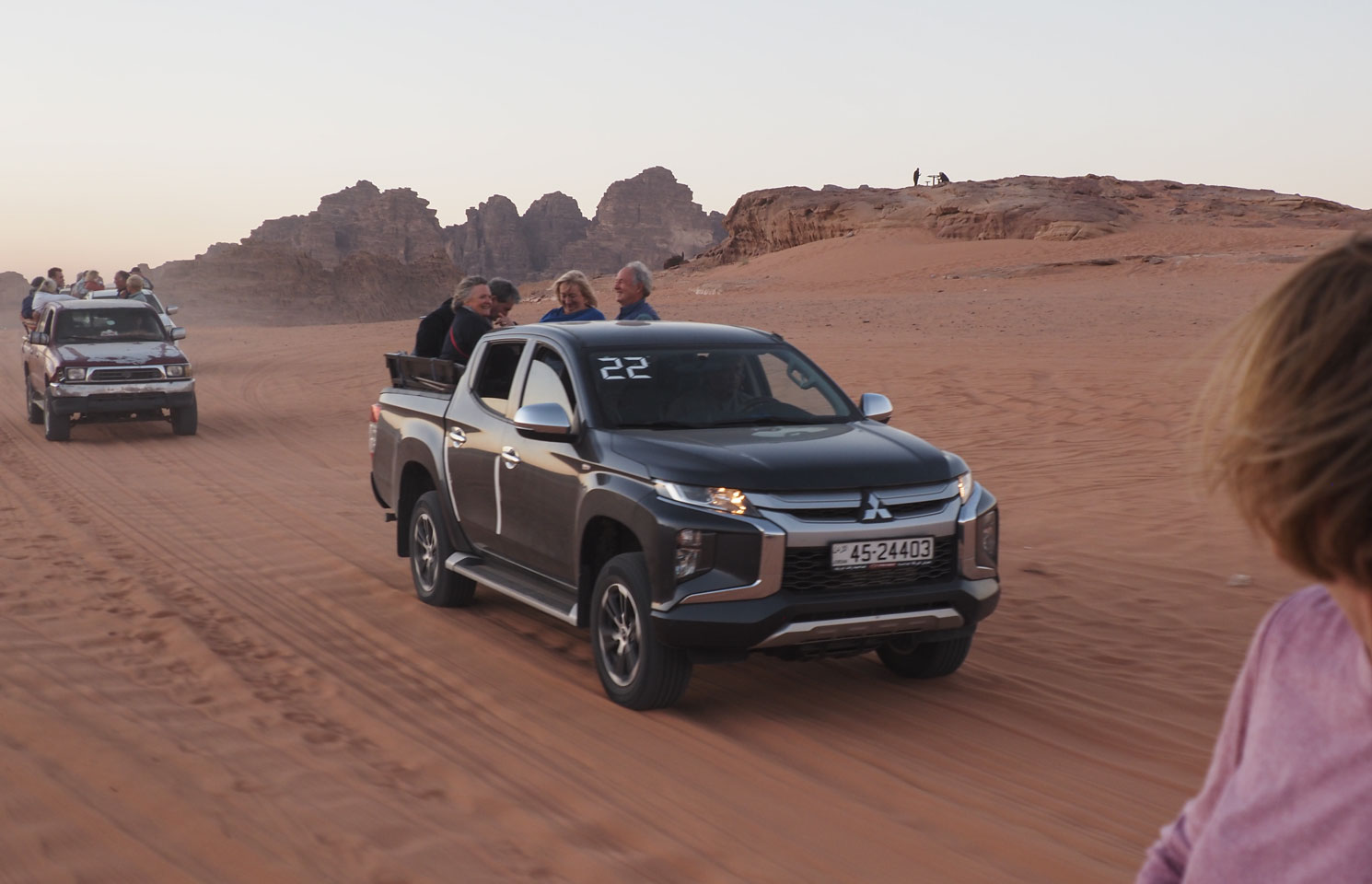
The "camp" turned out to be some tents arranged in a "U" shape, open to the center.
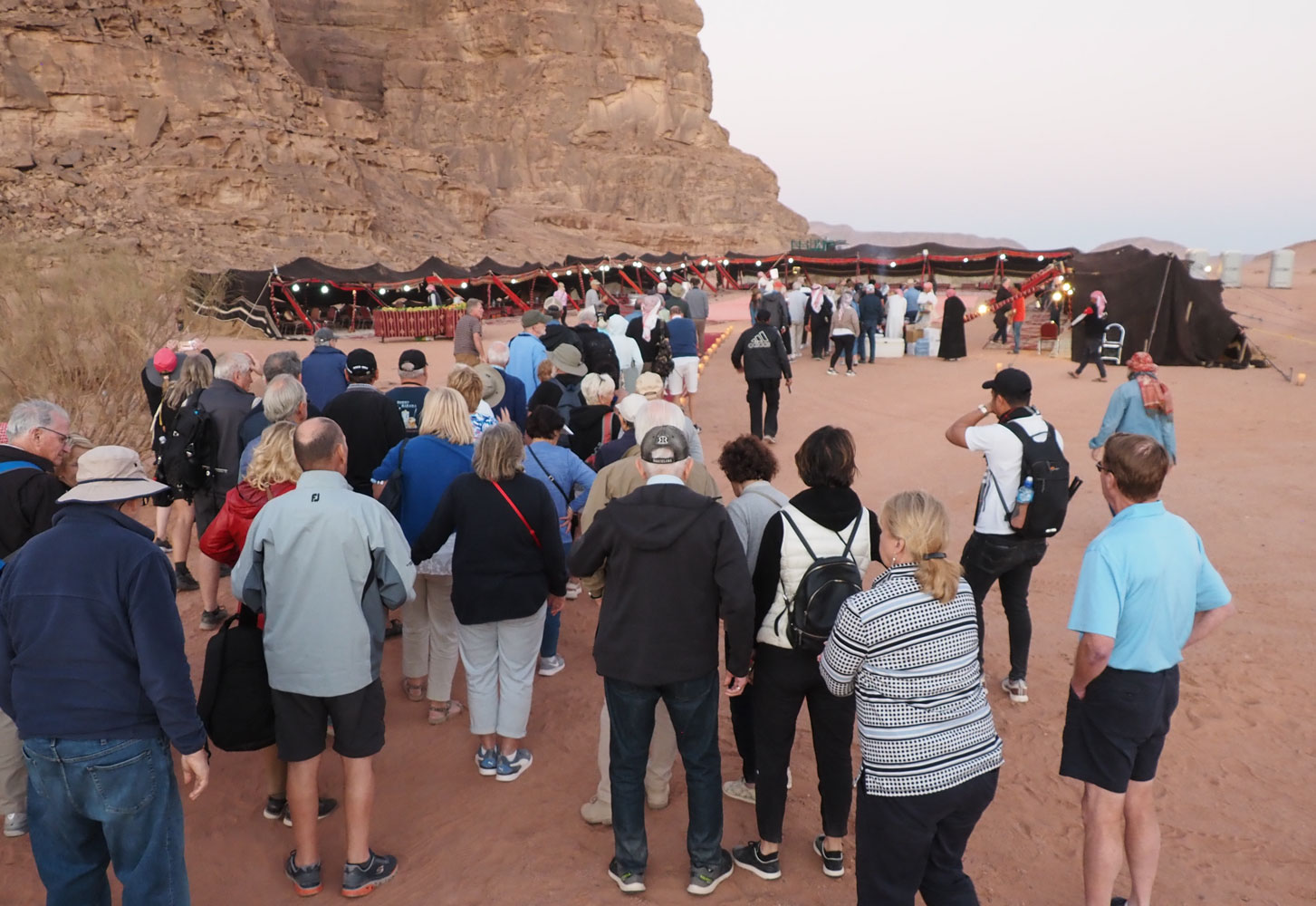
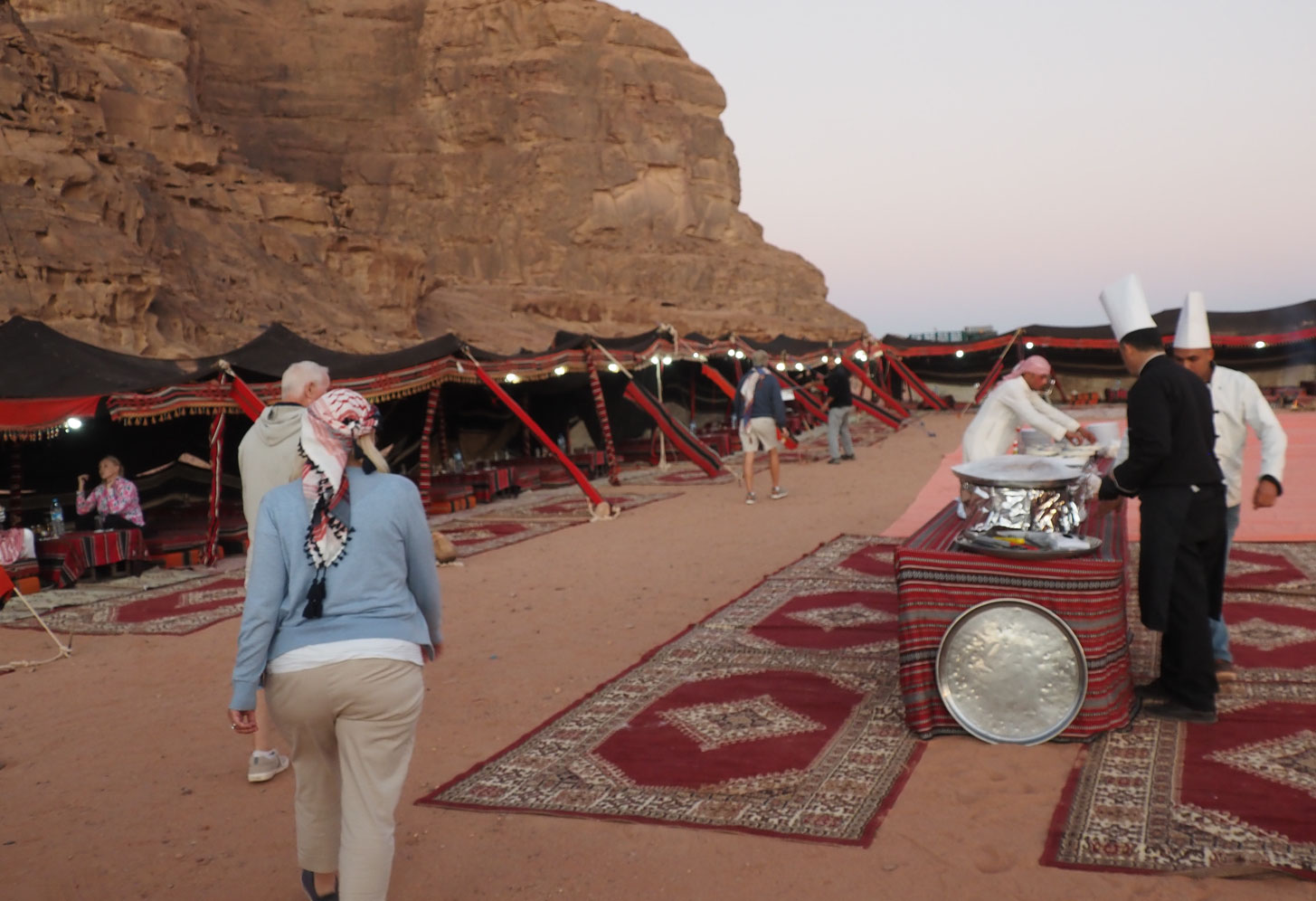
There were two long tables in the middle of the tents, where the food was to be served, buffet style.
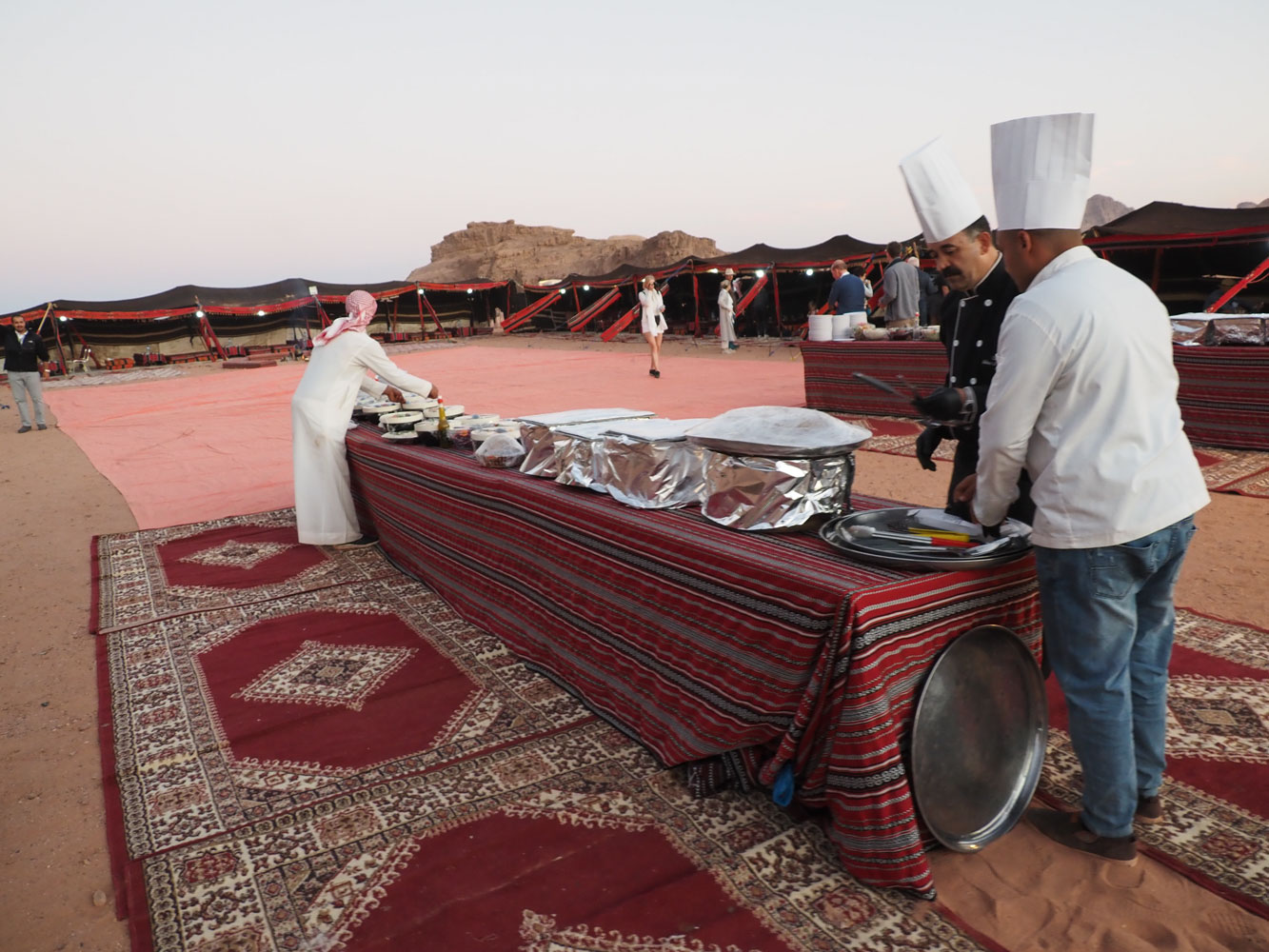
This was the eating arrangement - a low table and two cushions on either side of the table. It was difficult to sit down and to get up.
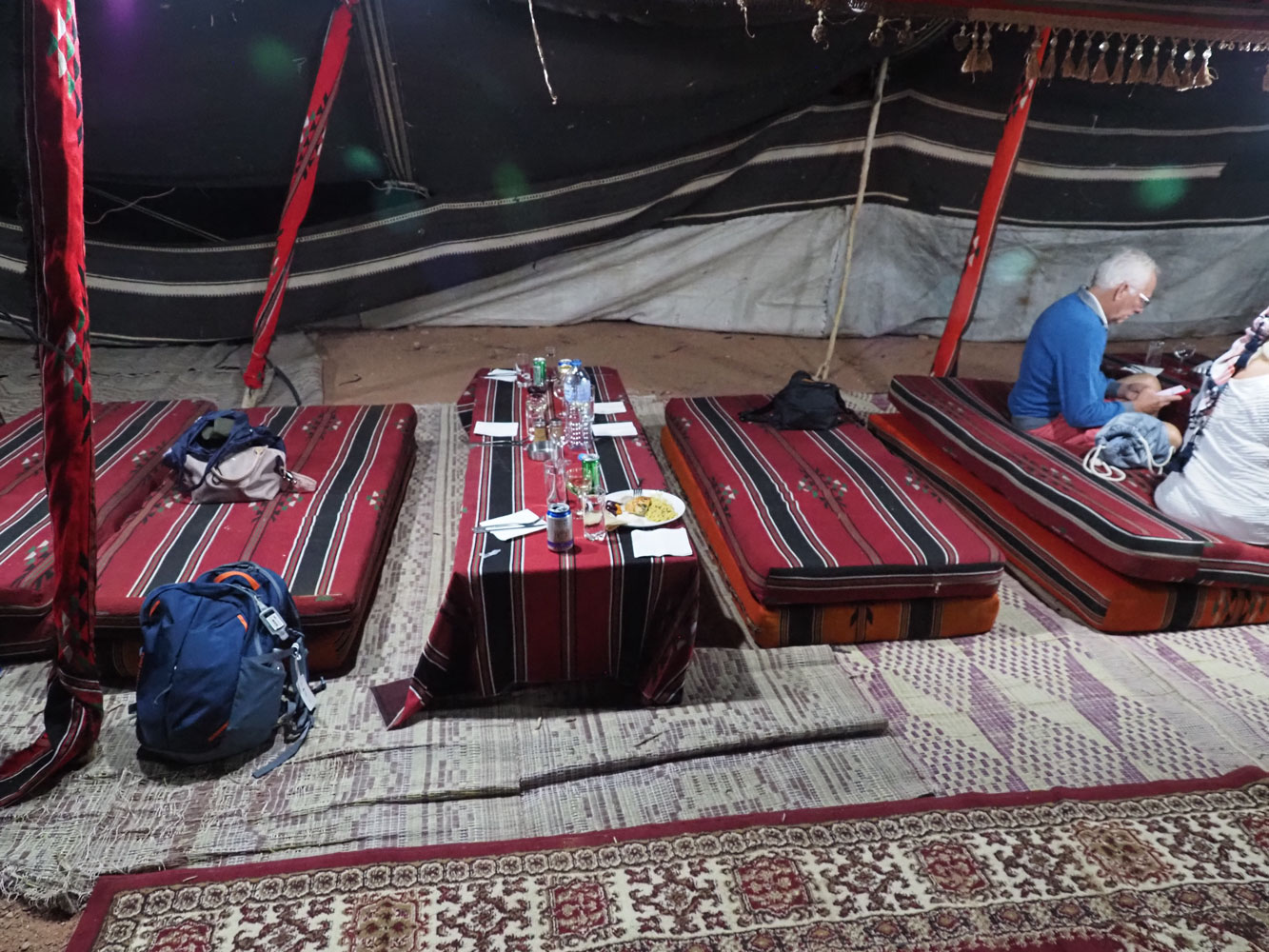
It eventually got desert dark.
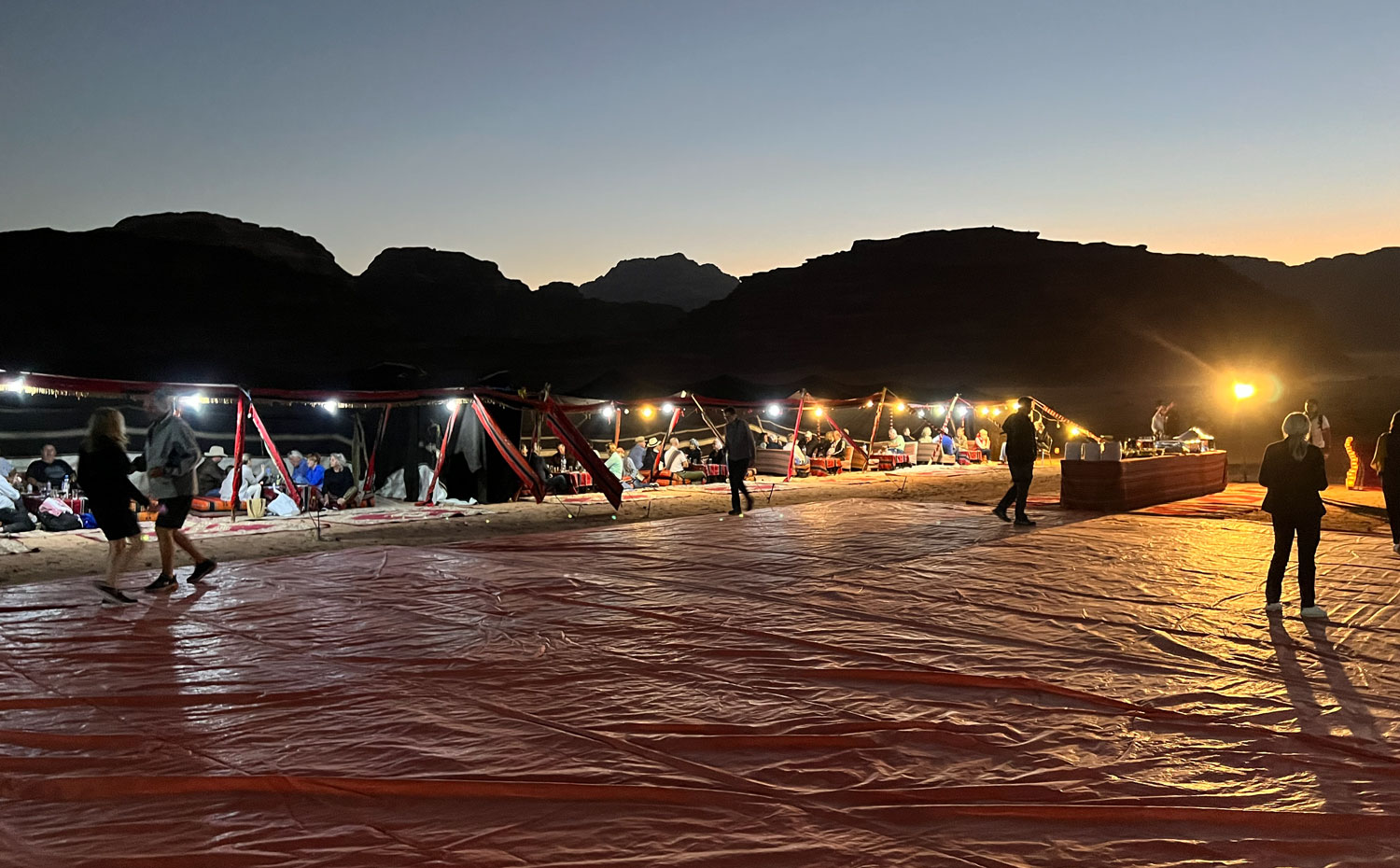
The cooks demonstrated how they cook in the desert. They build a fire in a hole to heat the sand. Then they put the food into the hole, in a closed pot, and cover the hole with hot sand.

Here they are digging the pots out of the sand.
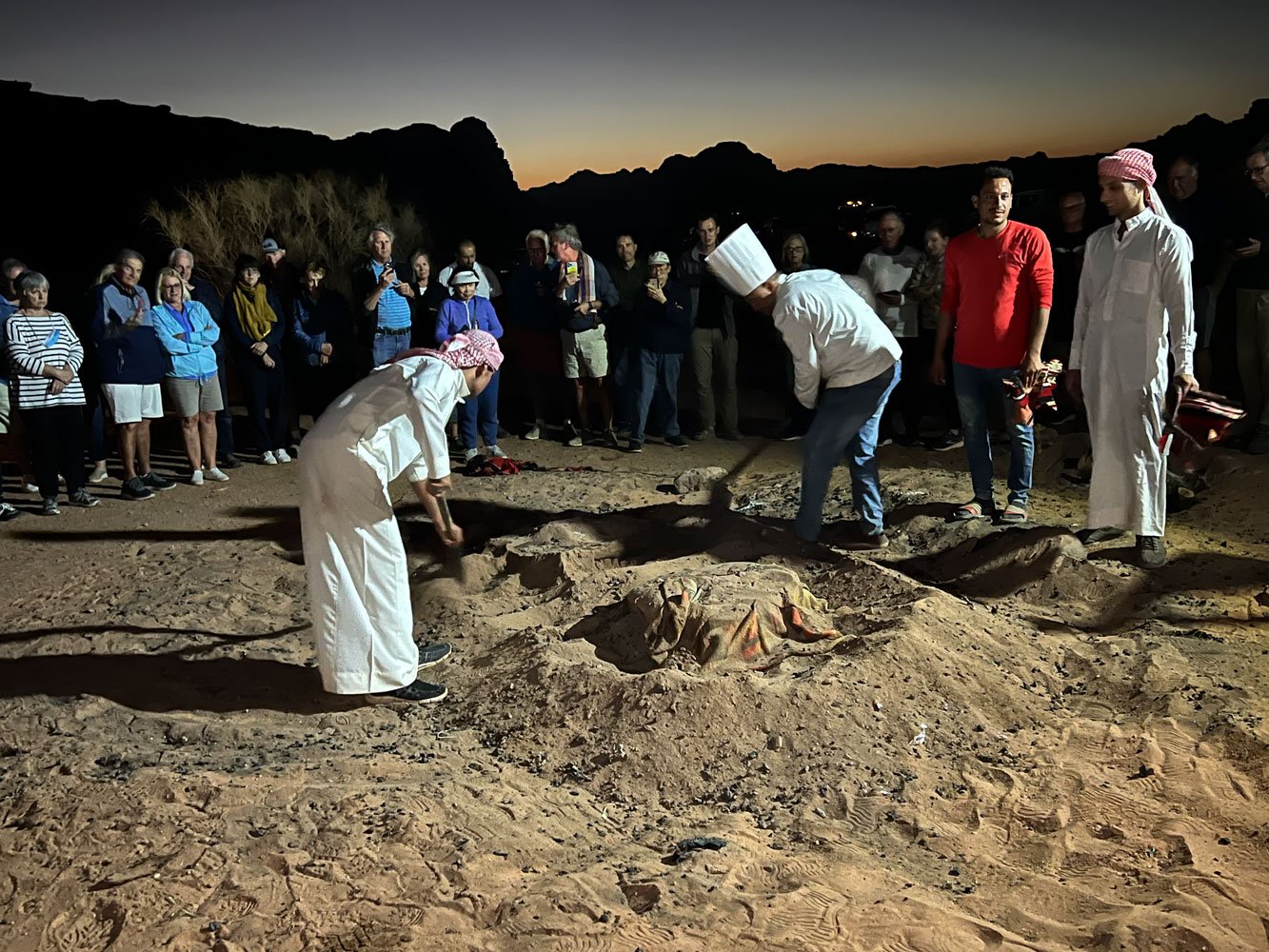
Removing the aluminum foil.
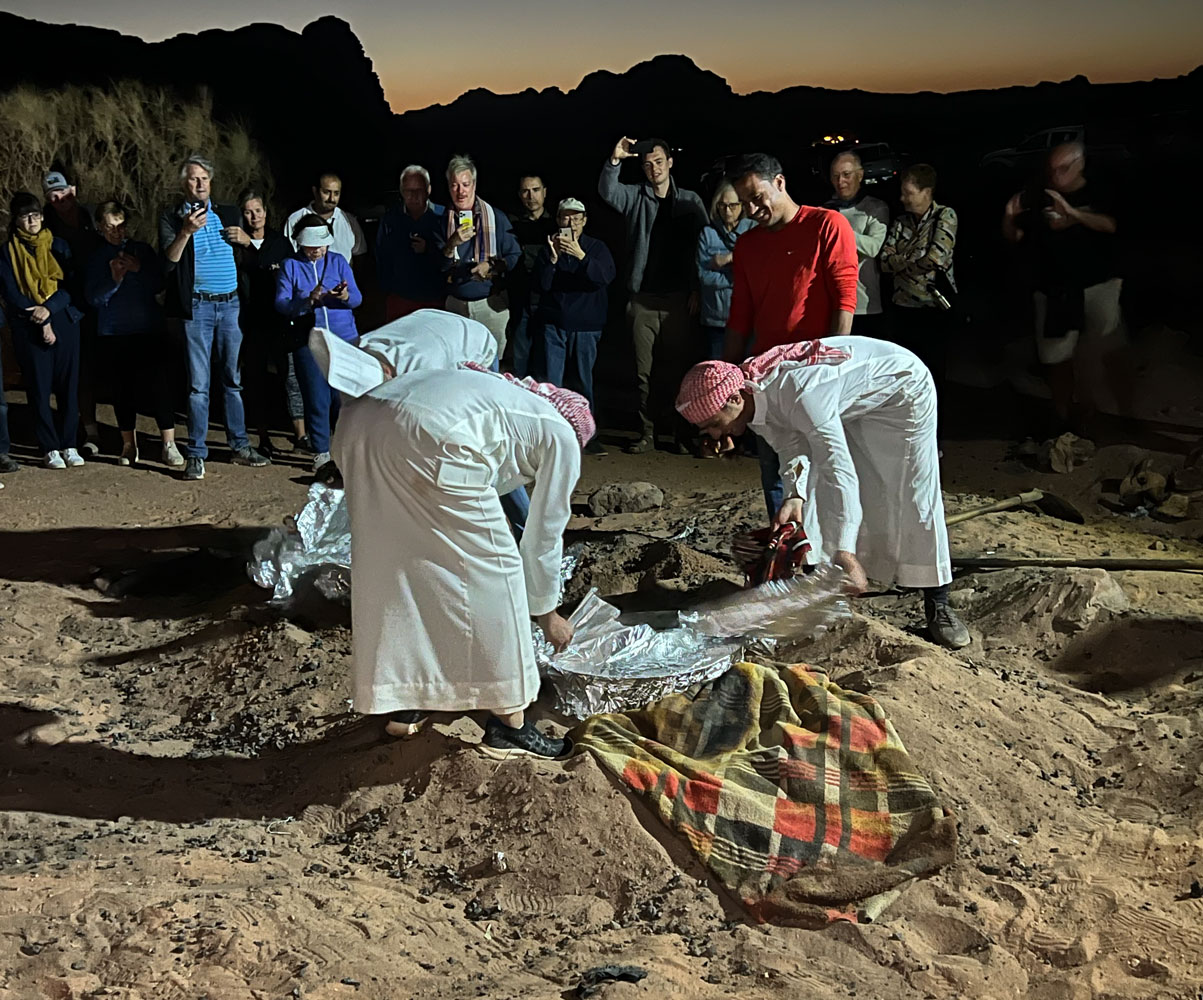
And here's the "pot". It has two levels, with the food wrapped in aluminum foil in each level.
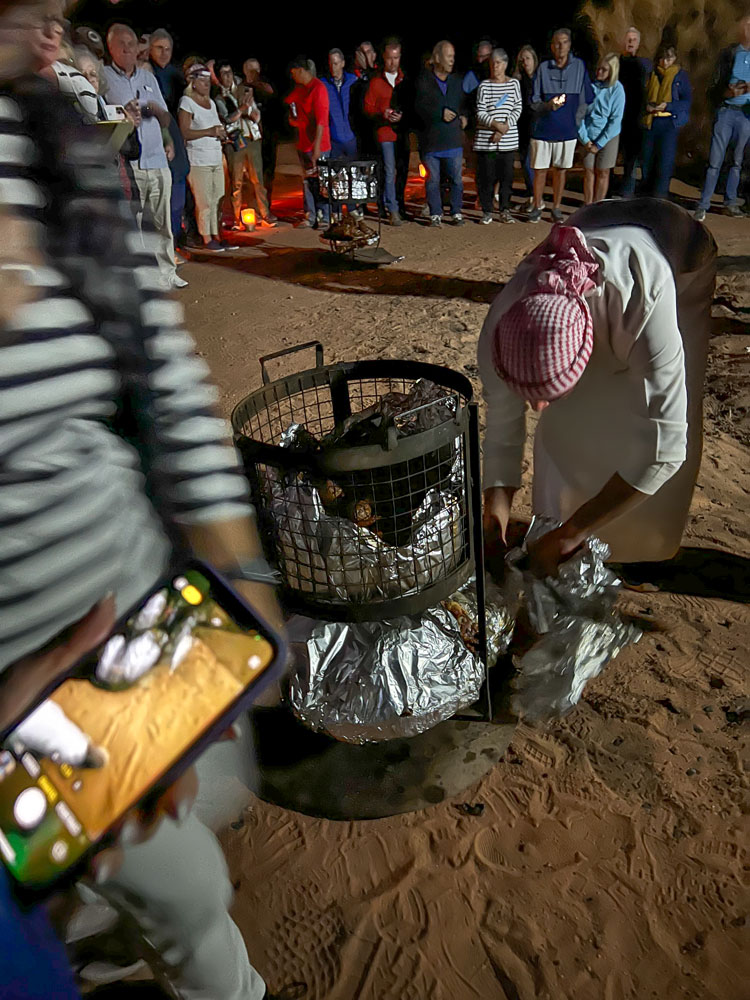
Then we lined up at the buffet tables. The problem was that we couldn't see what the dishes were. We had to use our iPhone lights to see things.
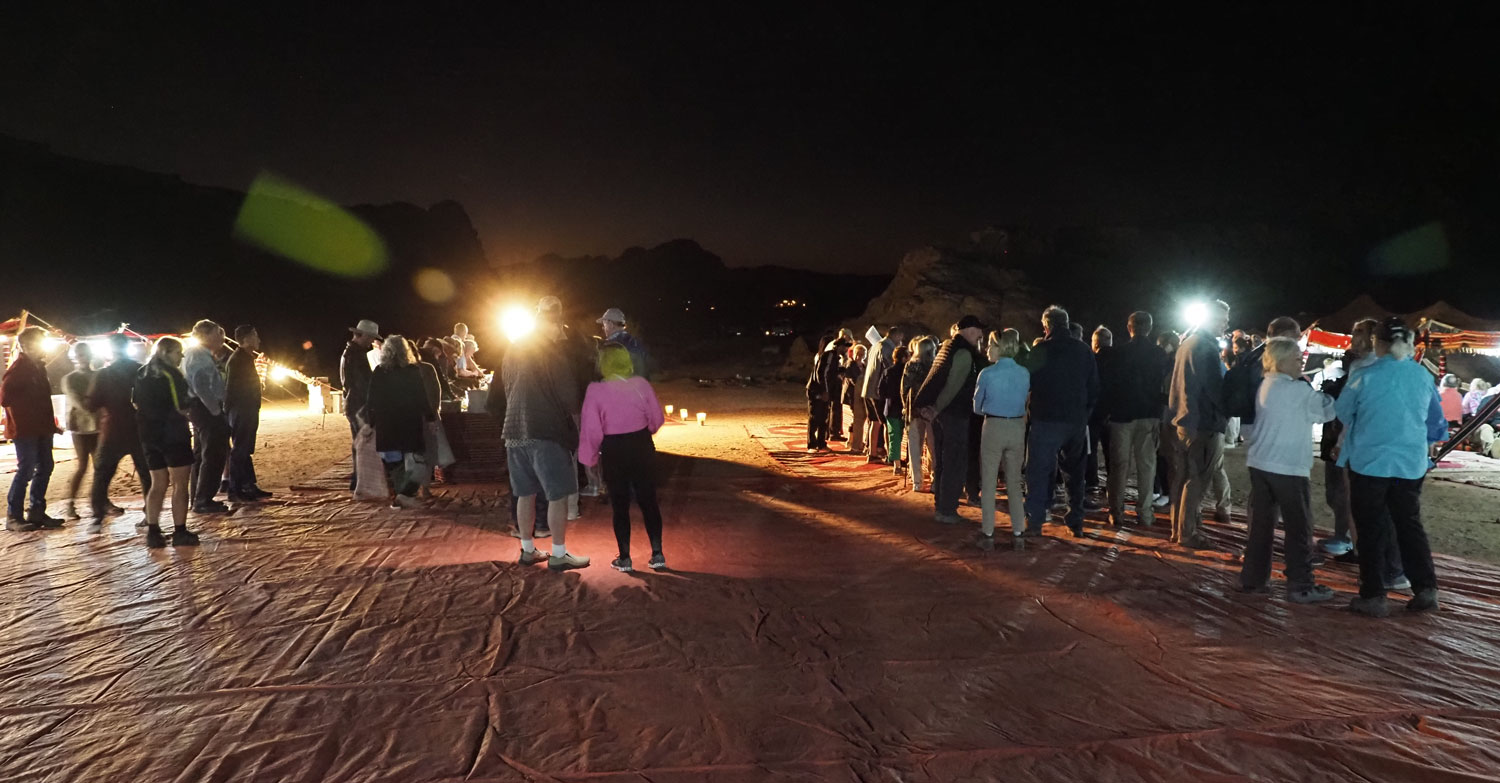
Maureen was on the tour alone - her husband did not come - and we hung out together. I took this picture of her at dinner.
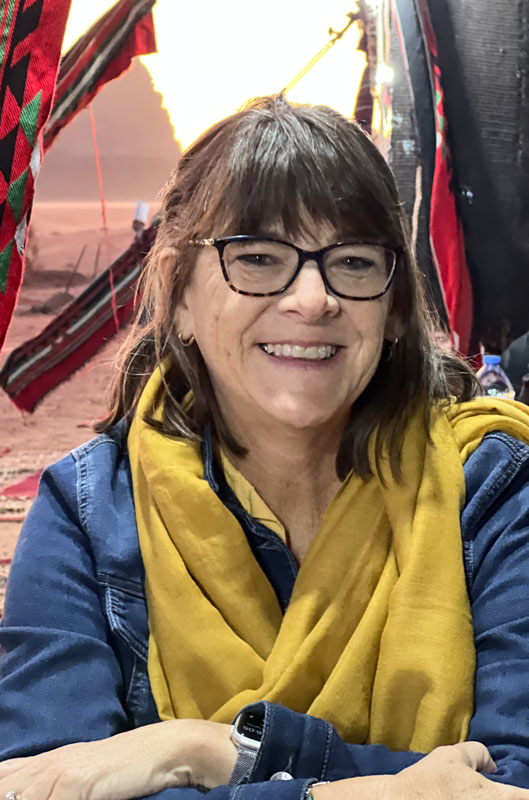
After dinner, we loaded back into the trucks for the ride back to the buses.
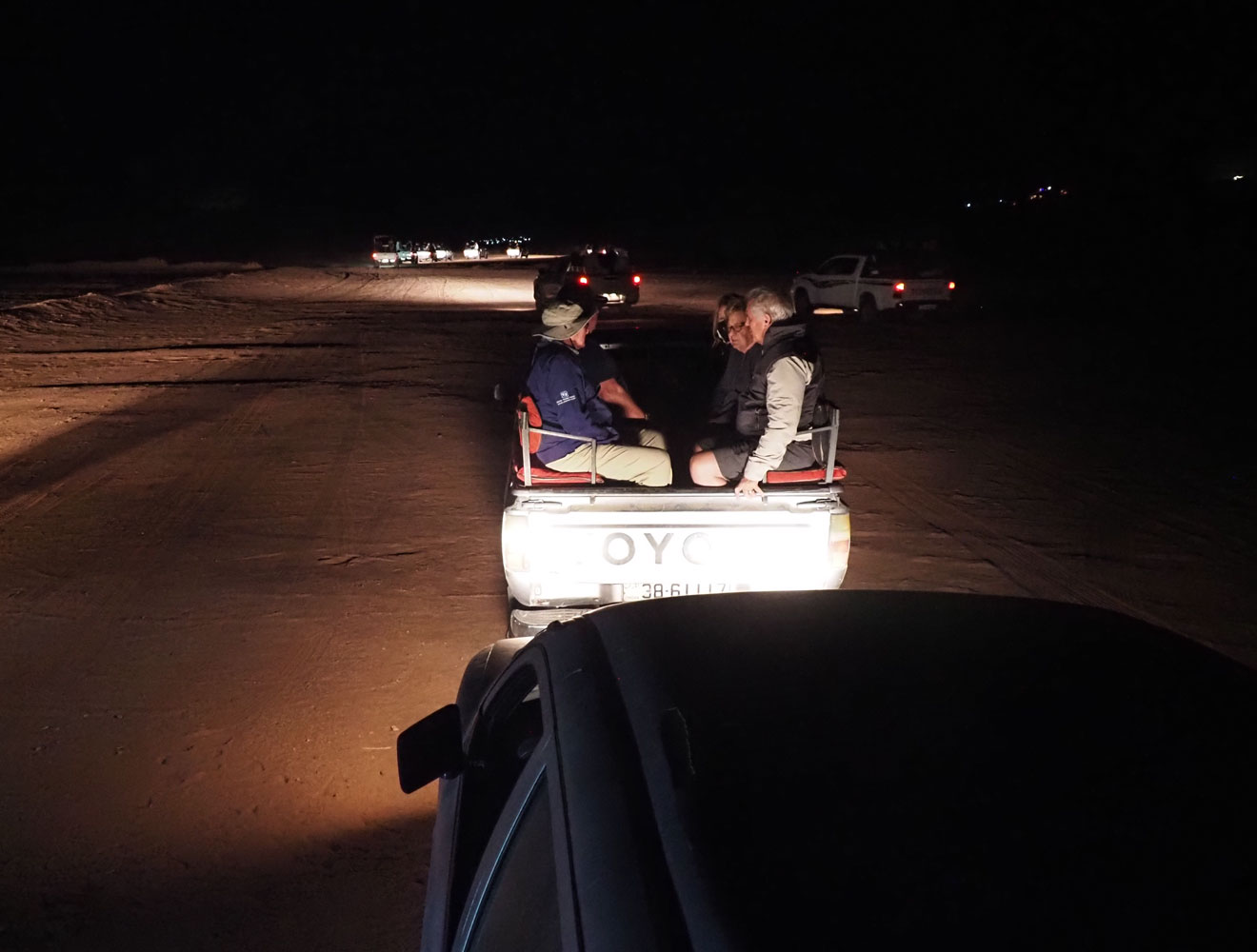
The moon was nearly full, and I was able to get a shot of the desert from the speeding truck.
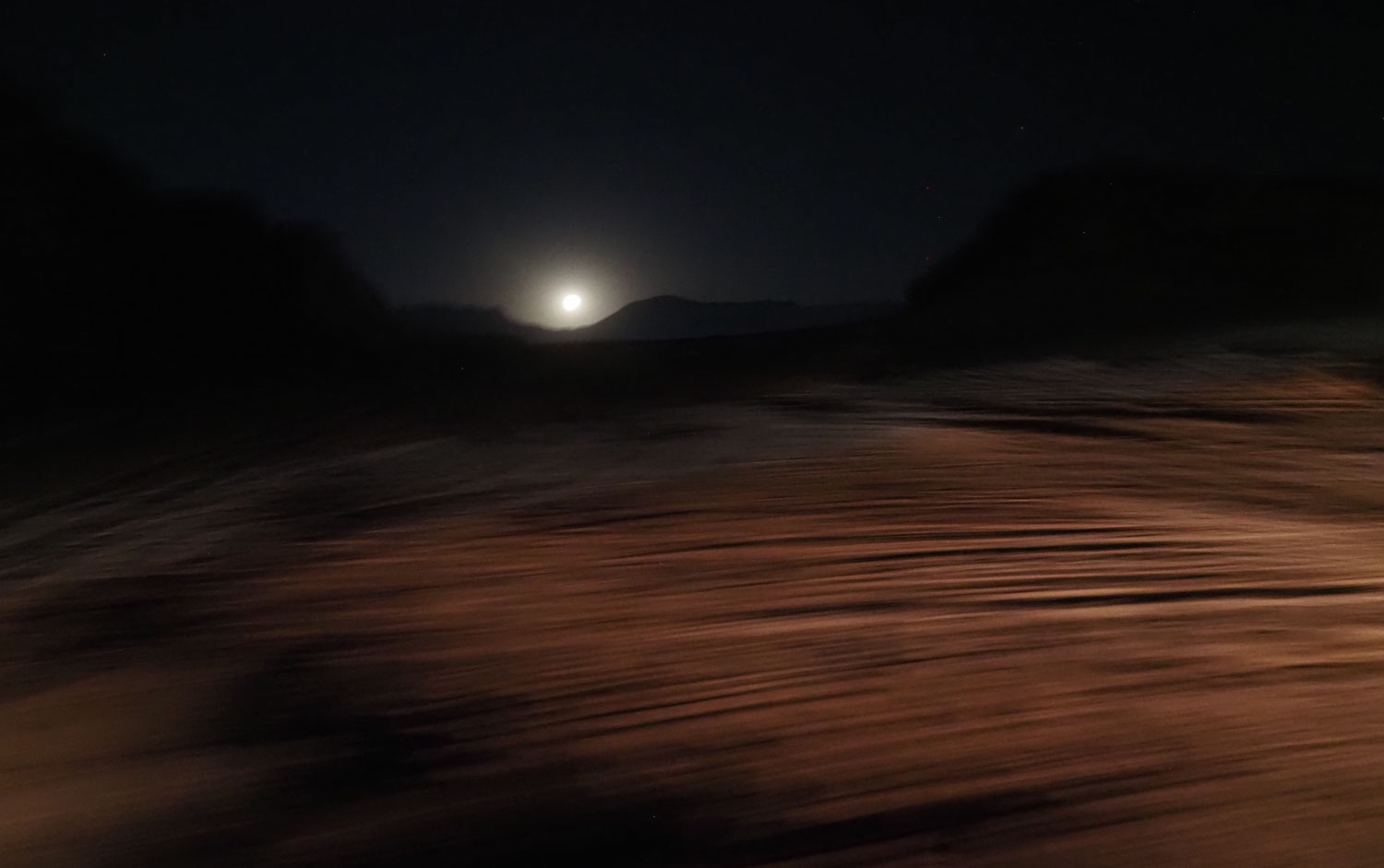
The ride back to the ship was a bit over an hour. We arrived about 9pm.
I couldn't help comparing this event to the dinner we had at Little Petra with Tauck back in 2017. It was a service dinner and included entertainment. A far better experience. But with Tauck, we were staying in Petra and we were a much smaller group. You can see our dinner at Little Petra here. Not my best photography, but I've gotten better cameras since then.
But, additionally, there's not much interesting about Wadi Rum. I had heard a lot about it, so I'm glad I had the opportunity to experience it myself, but I sure wouldn't go back.
That was the end of our day.